
INTRODUCTION TO WESTWOOD
Westwood is a neighborhood in Los Angeles’s Westside. It’s widely known for being home to the University of California, Los Angeles although locally it’s almost equally well known for its small shopping district, Westwood Village. People who’ve lived in Los Angeles longer than I are prone to speaking about Westwood with an elegiac tone normally reserved for “things that aren’t here anymore.” That’s always struck me as strange because events at Royce Hall and the Hammer bring me to Westwood semi-regularly and Westwood Village — whilst not my idea of a good time — certainly feels vibrant than most Westside neighborhoods.
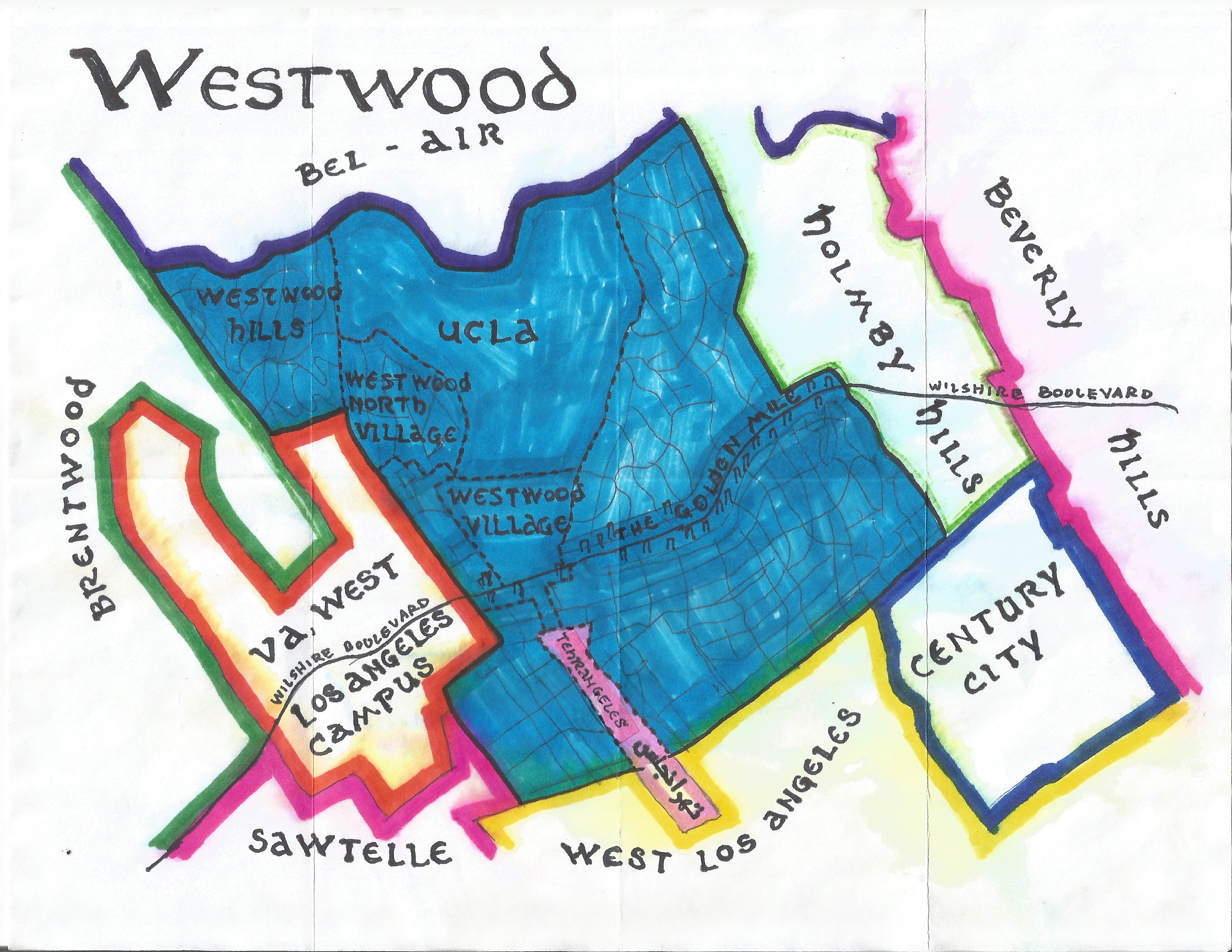
I first visited Westwood in 1998, about a decade after the apparent end of Westwood’s golden age. I found it then, as now, to be fairly walkable by Westside standards. There was a fair amount of interest, including the campus of UCLA, the Hammer, Rhino Records, Sisterhood Bookstore, and a strip of Persian businesses which stretched south into the neighborhood of West Los Angeles. If I’m not mistaken, I handed in an application to Penny Lane. There seemed to be a lot of people out and about, too. Granted, none of it was enough to make me want to relocate from Mideast Los Angeles to the Westside, but I’d seen worse.
PRE-WESTWOOD HISTORY
The first humans to settle in the Los Angeles Basin including the vicinity of what’s now Westwood were most likely the ancestors of the Chumash, who arrived at least 13,000 years ago. Some 3,500 years ago, the Tongva arrived from the east and apparently found most of inland Los Angeles abandoned by humans, with the Chumash by then clustered along the coast and Channel Islands. The Tongva established villages throughout the the region including one near Westwood, named Kuruvungna (also spelled Kuruvanga and Kuruvugna; meaning “a place where we are in the sun”) which was founded in what’s now Sawtelle sometime before the 5th century BCE.
The Spanish Portolá expedition arrived in the area in August 1769 and made contact with the residents of Kuruvungna. The Spanish renamed the sacred springs which nourished the villagers of Kuruvungna “Serra Springs,” after one of their own, Junípero Serra. In 1810, Mexico declared independence from Spain and in 1821 founded the Mexican Empire. In 1843, the Mexican government granted Rancho San Jose de Buenos Ayres to José Maximo Alanís, who’d settled the area in the 1820s.
EARLY AMERICAN ERA
The US conquered much of Mexico, including California, but the 1848 Treaty of Guadalupe Hidalgo ensured that preexisting land grants would be honored by the victors and thus Rancho San Jose de Buenos Ayres remained in Alanís’s hands. In 1866, however, ownership passed to Benjamin Davis “Don Benito” Wilson and W. T. B. Sanford. In 1884, 3,300 acres (13.4 square kilometers) of the property were sold to John Reid Wolfskill. After securing a right-of-way through Wolfskill Ranch for the Los Angeles and Pacific Railroad, the Los Angeles and Santa Monica Land and Water Company began planning a community named “Sunset.” Wolfskill, however, objected in court, won, and was awarded both the return of his confiscated land and $293,000 — over $7 million, adjusted for inflation. Wilson died in 1878 and left the ranch lands to his heirs but on 14 June 1916, the area was annexed by Los Angeles as part of the Westgate Annexation.
In 1919, Wolfskill’s heirs sold 400 acres (1.6 km2) of the ranch to Arthur Letts, the English-American founder of the department stores Bullock’s and Broadway Department Store. Letts set about developing two communities, one named Holmby Hills (its name derived from his birthplace, Holdenby, England) and the other, Westwood. In 1922, 1000 residential and commercial lots were advertised in the Los Angeles Times. Letts’s daughter, Gladys, had earlier married Harold Janss, president of the Janss Investment Company and when Letts died in May 1923, Janss assumed control of the Holmby Hills and Westwood developments.
UCLA
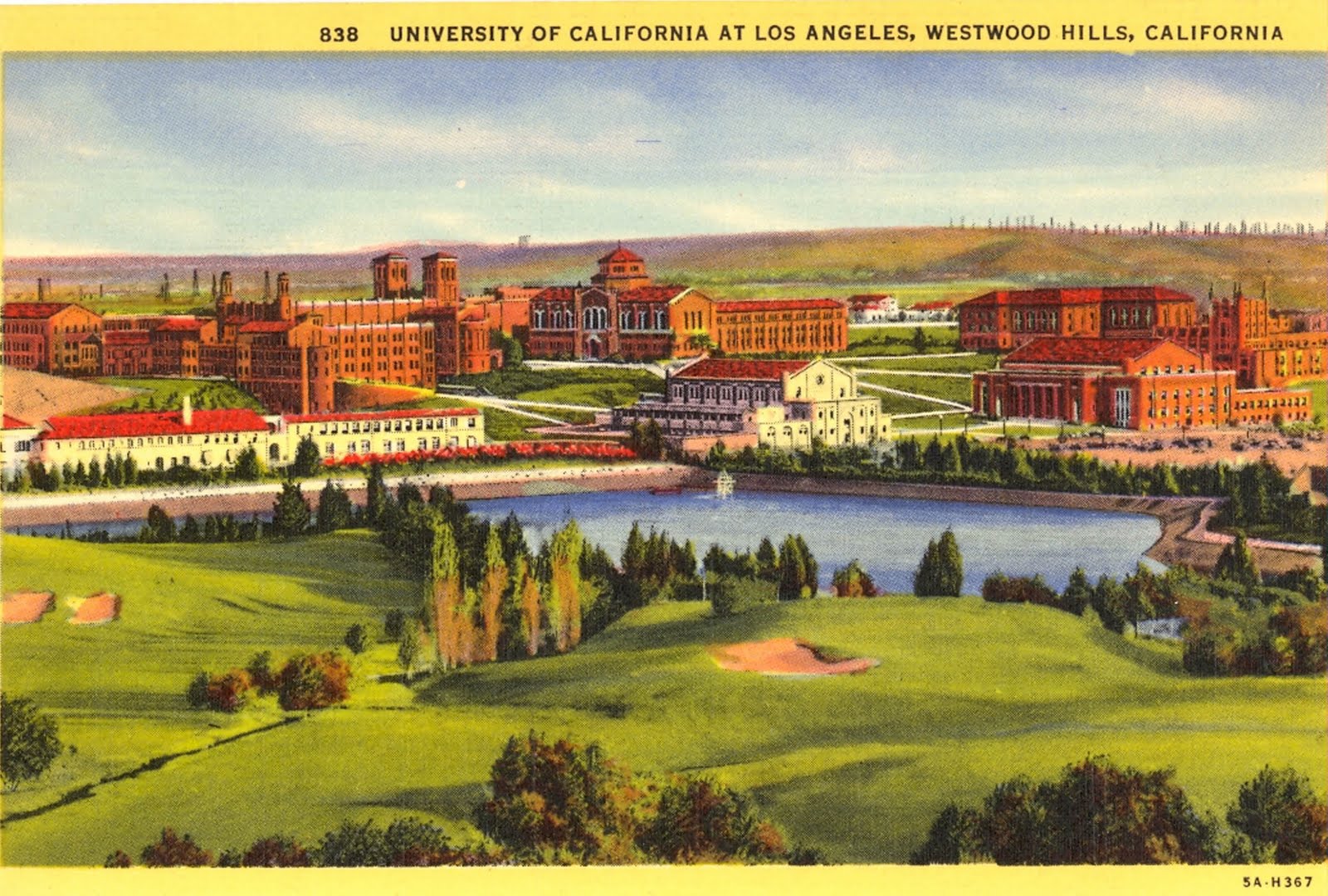
The University of California, Los Angeles had its roots in the Normal School of the State of California, which opened a southern branch, the State Normal School at Los Angeles, in Downtown Los Angeles in 1882. In 1887, the school was renamed the Los Angeles State Normal School. In 1914, the school relocated to a campus which is now home to Los Angeles City College, in East Hollywood. In 1919 it was designated the second school in the University of California system and was renamed the Southern Branch of the University of California. Within a few years, enrollment was such that the school sought out a new campus location. Two options were considered, Palos Verdes Peninsula and Westwood. They obviously went with the latter and UCLA moved to its current location. The university was renamed the University of California at Los Angeles in 1927 (the final tweak, to University of California, Los Angeles, took place in 1953). Ground broke for a new campus north of Westwood Village and west of Holmby Hills. The first students were admitted to the new campus in 1929.
The first four buildings on campus were the Chemistry Building (now Haines Hall), the College Library (now Powell Library), the Physics-Biology Building (now the Humanities Building), and Royce Hall. All four were designed in the Romanesque Revival style by Allison & Allison. The stately style remained the predominant architecture aesthetic of subsequent buildings until the 1950s when Welton Becket supervised a campus expansion. Later buildings were designed by high-profile architects including A. Quincy Jones, Cesar Pelli, I.M. Pei, Paul R. Williams, Rafael Vinoly, Richard Meier, Richard Neutra, Robert Alexander, William Pereira, and Venturi, Scott Brown & Associates.
NORTH VILLAGE WESTWOOD & RESIDENTIAL ARCHITECTURE

I arrived in Westwood via Metro‘s Rapid 720 line. The ridiculousness of there not being a train along Wilshire Boulevard was comically underscored by the fact that toward the end, there were six of these articulated buses on a single block. Surely a train would have made more sense — but Gaylord Wilshire, who died in 1927, stipulated that no rail lines or heavy trucking ever be allowed along his namesake boulevard and who are we, 91 years later, to argue with his divine proclamation?

Exiting the bus I passed along the edge of Westwood Village for Weyburn Terrace and a residential area I was until then unaware had its own designation — North Village Westwood. Although the UCLA campus and Westwood Village command most of the attention, including architectural, the majority of Westwood is dominated by large swathes of exclusively residential neighborhoods and within them are a great many exceptional examples of residential architecture. Here are just a few:
- The Holmby House (1221-1223 Holmby Avenue, Mediterranean style duplex, 1928, Los Angeles Historic-Cultural Monument No. 318).
- The Grove (10669-10683 Santa Monica Boulevard, Los Angeles Historic-Cultural Monument No. 319) is a French Revival-Style bungalow court designed by Allen Siple and built in 1932. The two rear cottages were designed by Edla Muir and added in 1940.
- Chateau Colline (10337 Wilshire Boulevard) is a Chateauesque multi-family residence designed by Percy Parke Lewis and built in 1935.
- The Lindbrook (10800-10808 Lindbrook Drive, Los Angeles Historic-Cultural Monument No. 324) is a Mediterranean Revival-style courtyard apartment built in 1935.

- The Landfair Apartments (10940-10954 Ophir Drive, Los Angeles Historic-Cultural Monument No. 320) are International-style apartments designed by Richard Neutra and built in 1937.
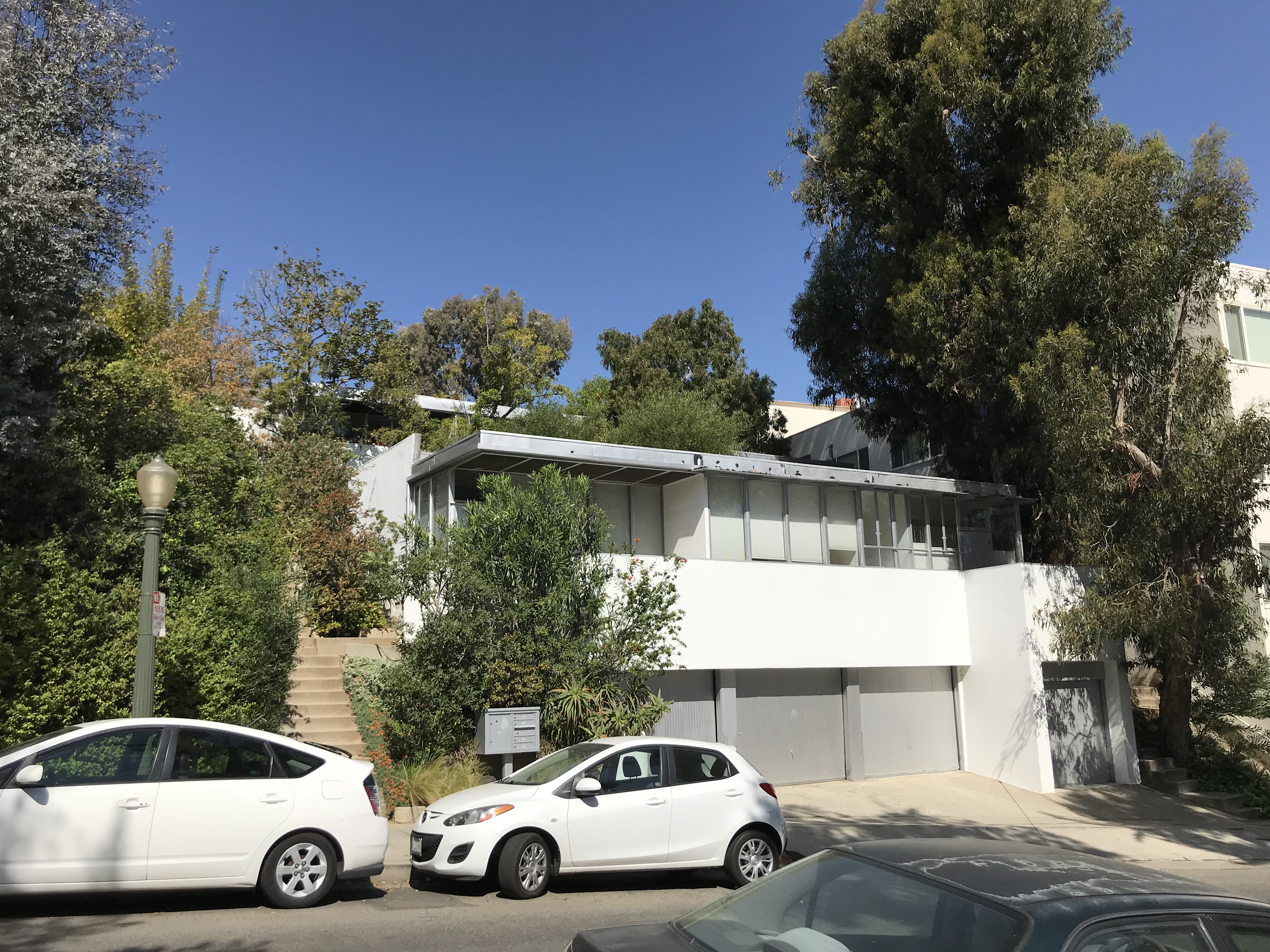
- The Strathmore Apartments (11005–11013 1⁄2 Strathmore Drive, Los Angeles Historic-Cultural Monument No. 351) are International-style apartments designed by Richard Neutra and built in 1937.

- Gayley Terrace (959 Gayley Avenue, Los Angeles Historic-Cultural Monument No. 363) is a Spanish Colonial Revival-style apartment complex designed by Laurence B. Clapp and built in 1940.

- The Kelton Apartments (644-648 Kelton Avenue) are International-style apartments designed by Richard Neutra and built in 1941.

- The Elkay Apartments (638-642 Kelton Avenue) are an International-style apartment complex designed by Richard Neutra and built in 1948 for violist Louis Kievman (the name is derived from his initials).
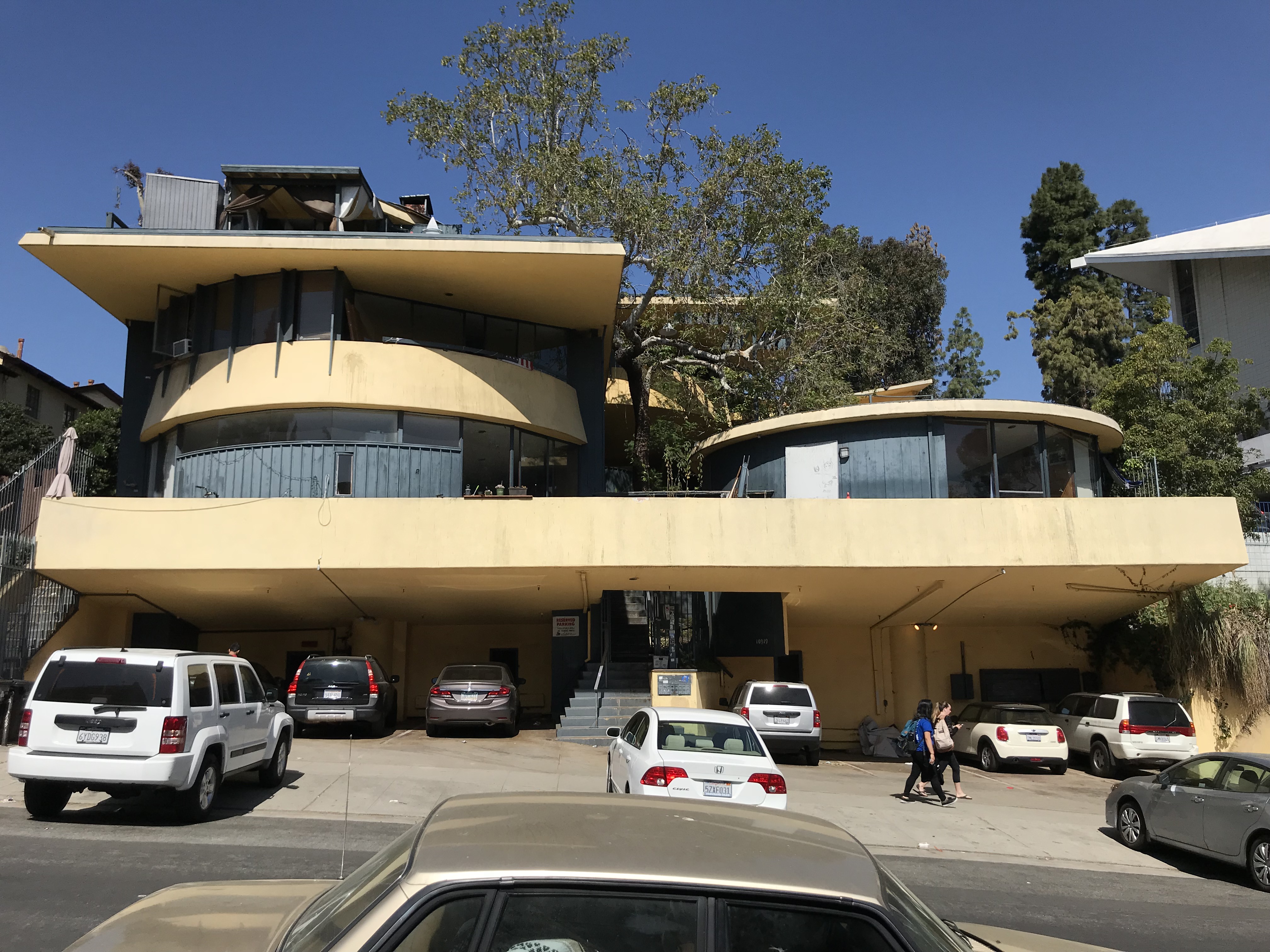
- The Sheats Apartments (also known as L’Horizon, 10919 Strathmore Drive, Los Angeles Historic-Cultural Monument No. 367) is a Futurist-style apartment complex designed by John Lautner and built in 1949 for artist Helen Taylor Sheats, who contributed to the design, and her husband, UCLA dean Paul Henry Sheats.
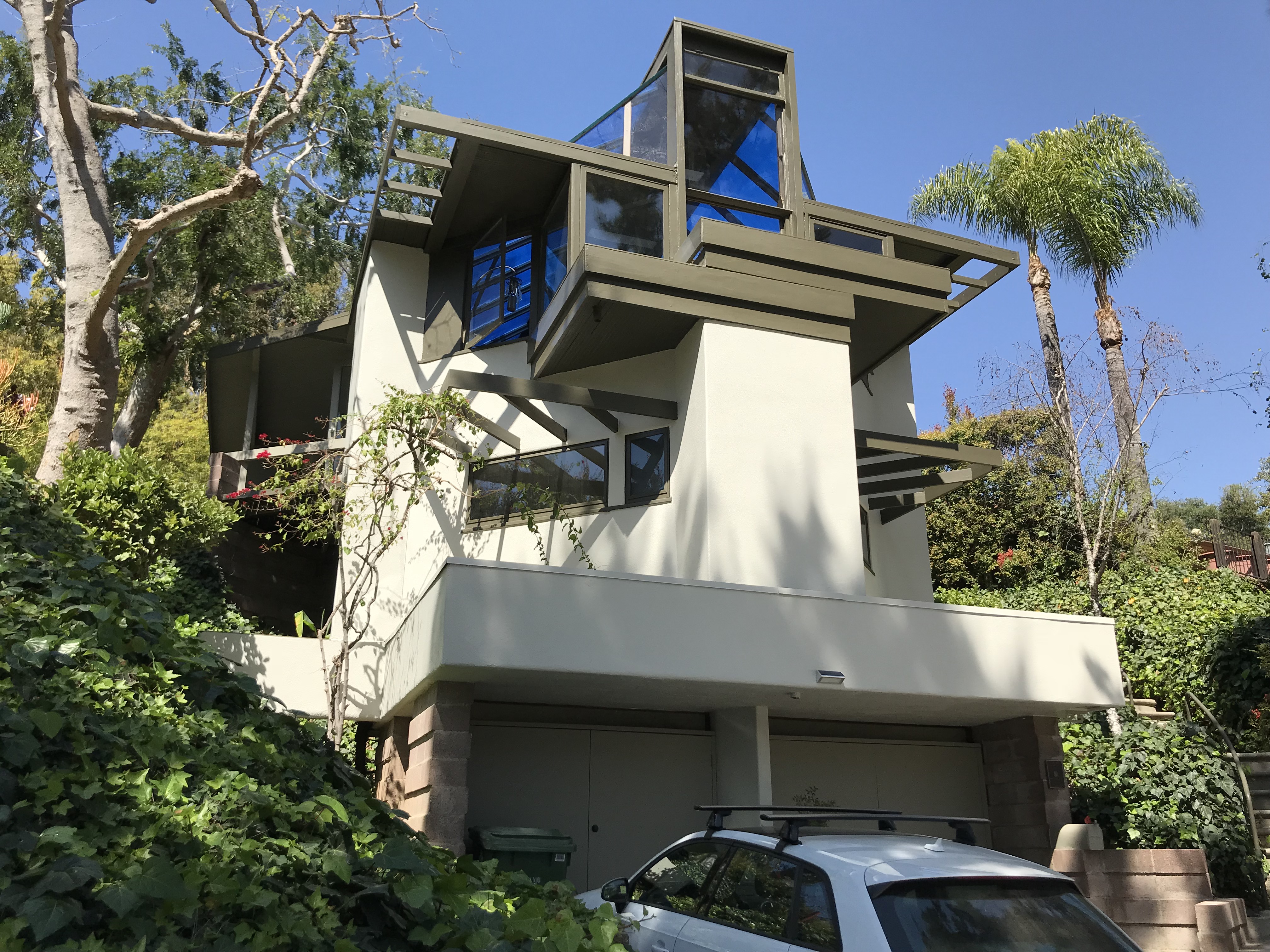
- The Tischler House (175 Greenfield Avenue, Los Angeles Historic-Cultural Monument No. 506) is a Mid-Century Modernist home designed by R. M. Schindler and built in 1949 for artist Adolph Tischler and his wife, Beatrice.
- The Moore-Rogger-Hofflander Condominium Building (1725 Selby Avenue) is a Late Modern-style complex designed by Charles Moore and Richard Chylinski and built in 1975.
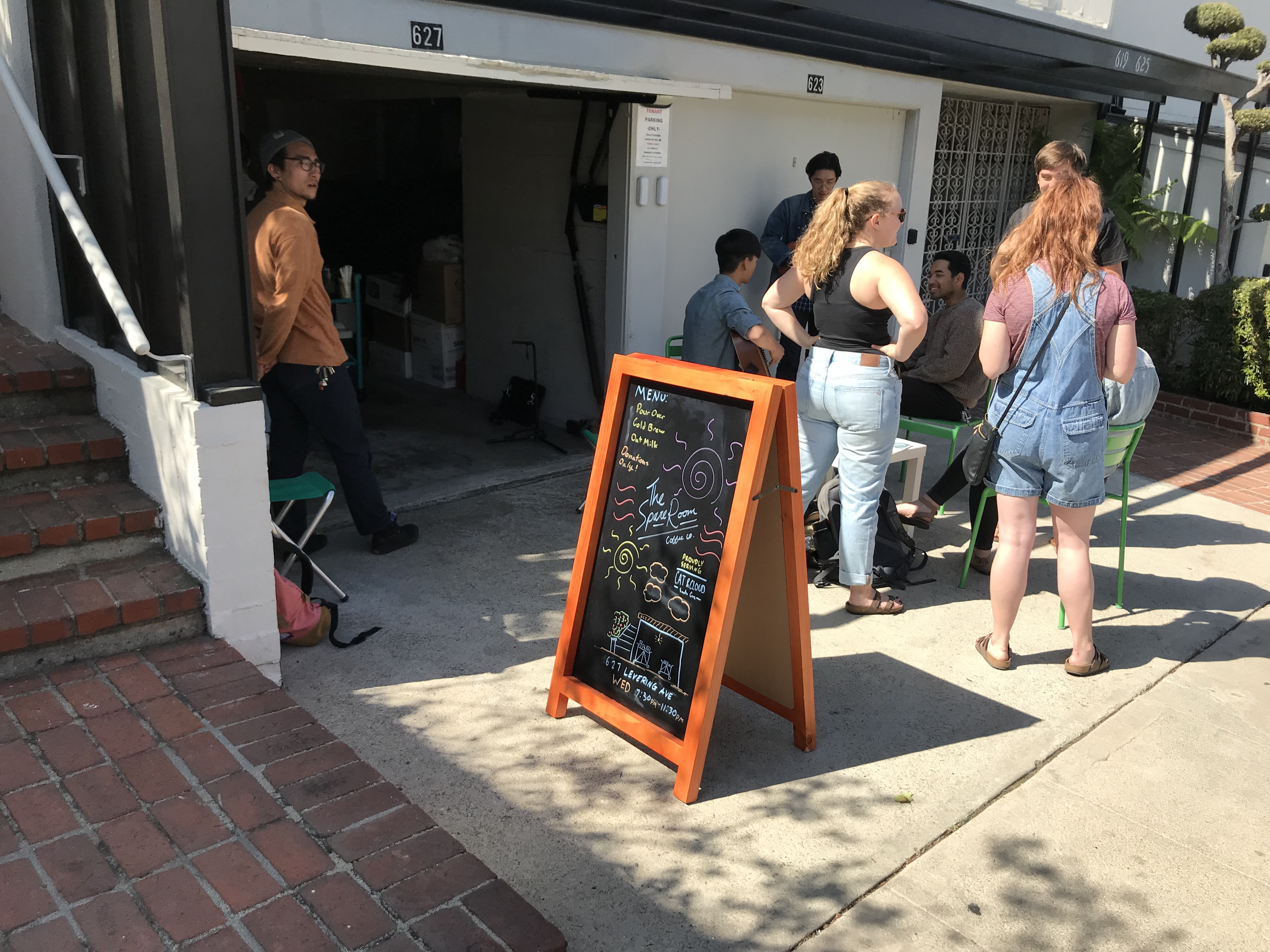
One of my favorite moments in North Village Westwood, however, had almost nothing to do with architecture. I quite unexpectedly stumbled across The Spare Room Coffee Company, a donation-only coffee bar operating out of a garage at 627 Levering Avenue. There were about half a dozen people gathered, mostly drinking coffee. Three young men played a folkish tune on guitars. From all appearances it seemed to be open even though, according to the sandwich board, it’s only open on Wednesdays from 7:30pm-11:30pm and its having been around 9:00 it should’ve been closed. I’m assuming, however, that the chalk artist merely confused post meridiem with ante meridiem –probably before the caffeine kicked in. Just one of the many compelling reasons we should abandon the antiquated 12-hour clock for the in-every-way superior 24-hour.
EXPLORING THE UCLA CAMPUS
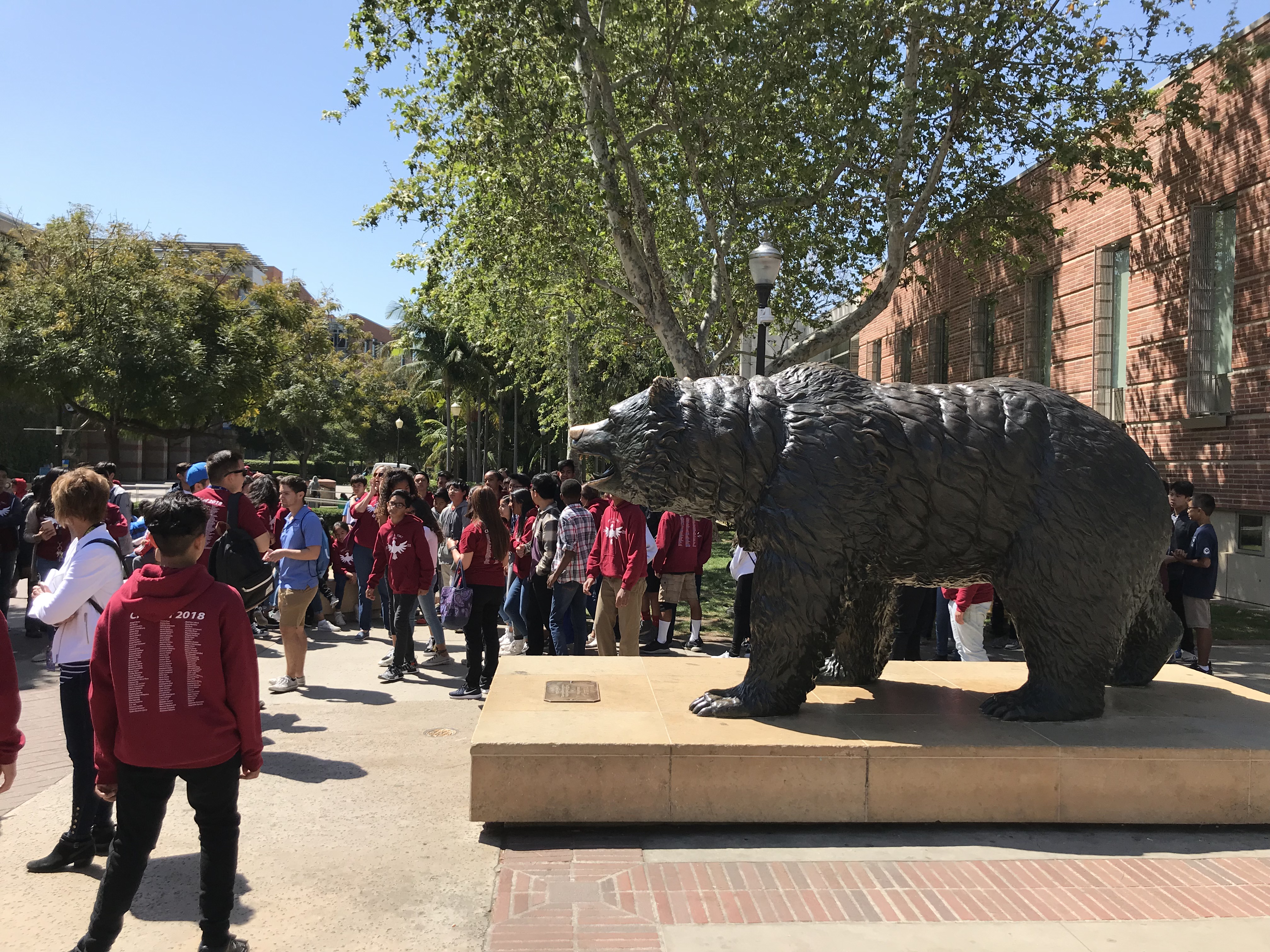
After strolling around North Village Westwood I decided to head over to the UCLA campus. I felt a bit self-conscious, to be honest, walking amongst these young adults on their way to and from class, so clearly not enrolled there. As a child, I used to sneak into a country club to use their indoor pool and play Q*bert. I did it so often, in fact, that the staff would greet me by name and must’ve wrongly assumed that I had wealthy parents. It’s harder for me to pass as a 21st-century college student, though. Even if I shaved off my graying whiskers, I don’t own a backpack. It’s also just not within me to — under any circumstances — wear pyjamas in public, a baseball cap, or cologne that smells like cotton candy mixed with lager and Fruit Loops. But there are plenty of (non-pervy) rewards for the non-student visitor.
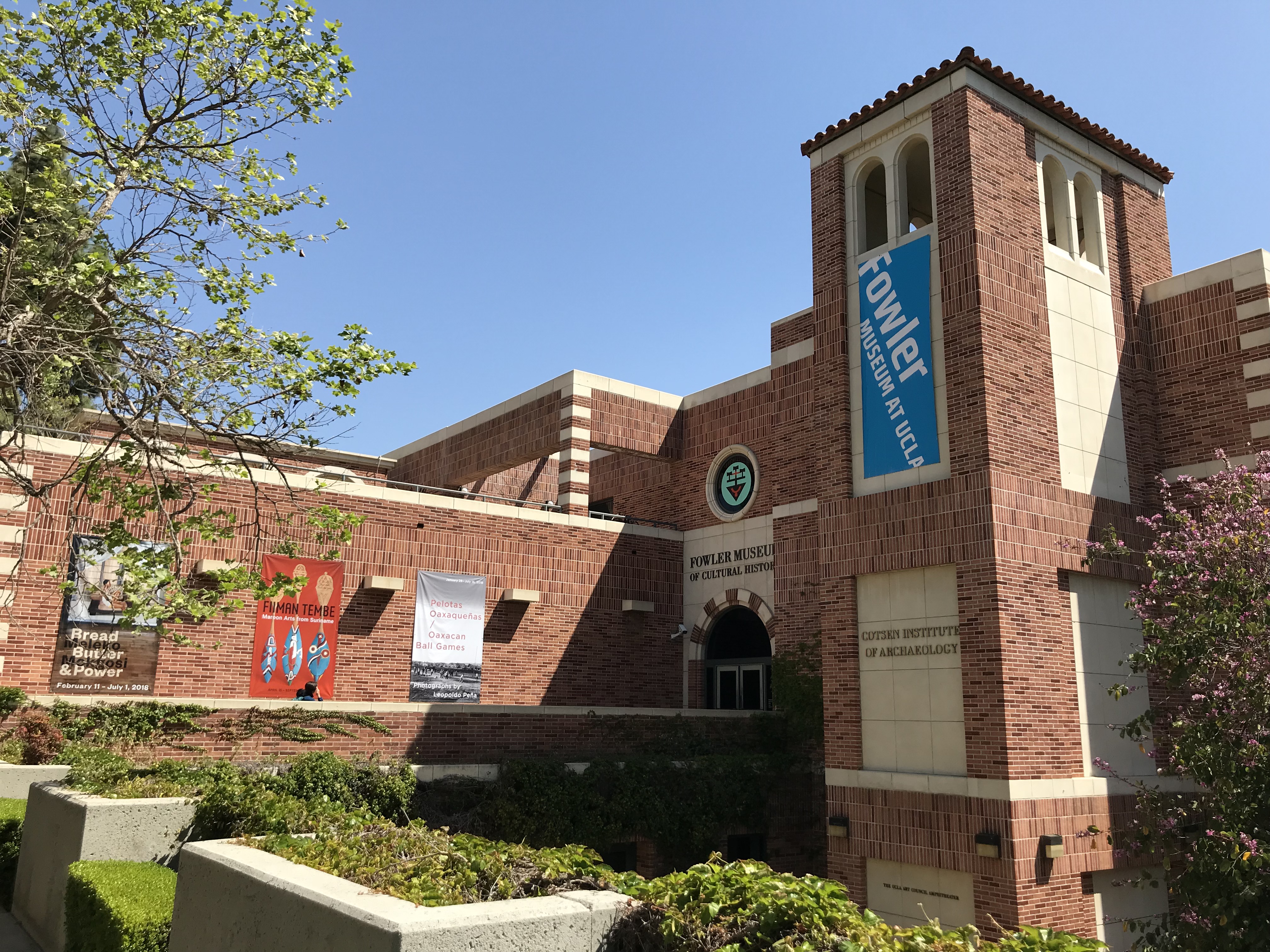
I first headed to the Fowler Museum, which I found was not yet open. Knowing it would be closed beforehand, I nevertheless headed next to Royce Hall, simply because it’s a beautiful building and probably accounts for nearly half of my visits to the Westside.
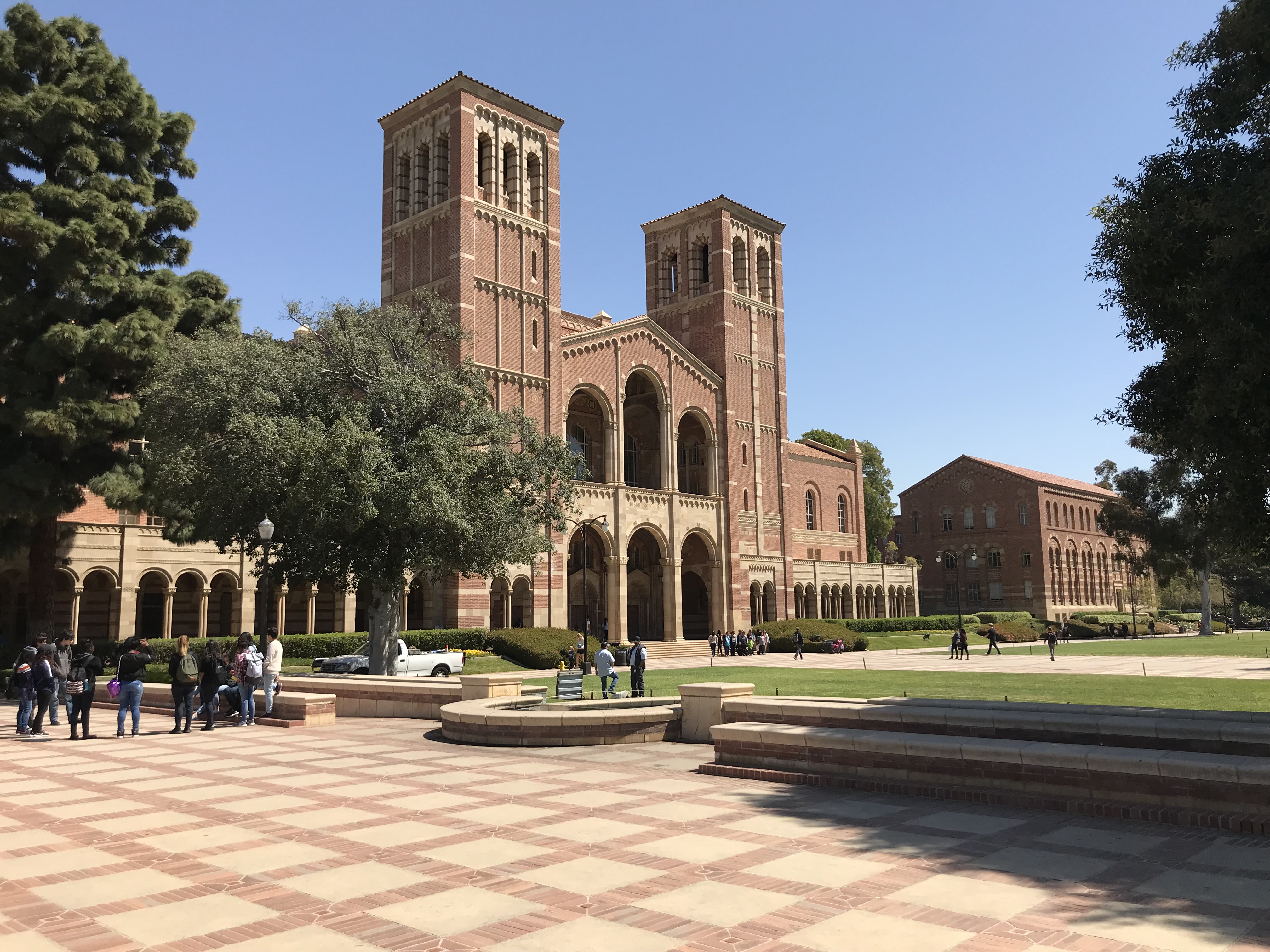
In the past few years, I’ve gone there to see performances by contemporary dance company Helios Dance Theater, Indonesian gamelan ensemble Gamelan Çudamani, Tuvan throat-singing group Huun-Huur-Tu, and Bostonian indie act Magnetic Fields. When Metro‘s Purple Line finally arrives in Westwood, I’ll probably attend performances there even more often.
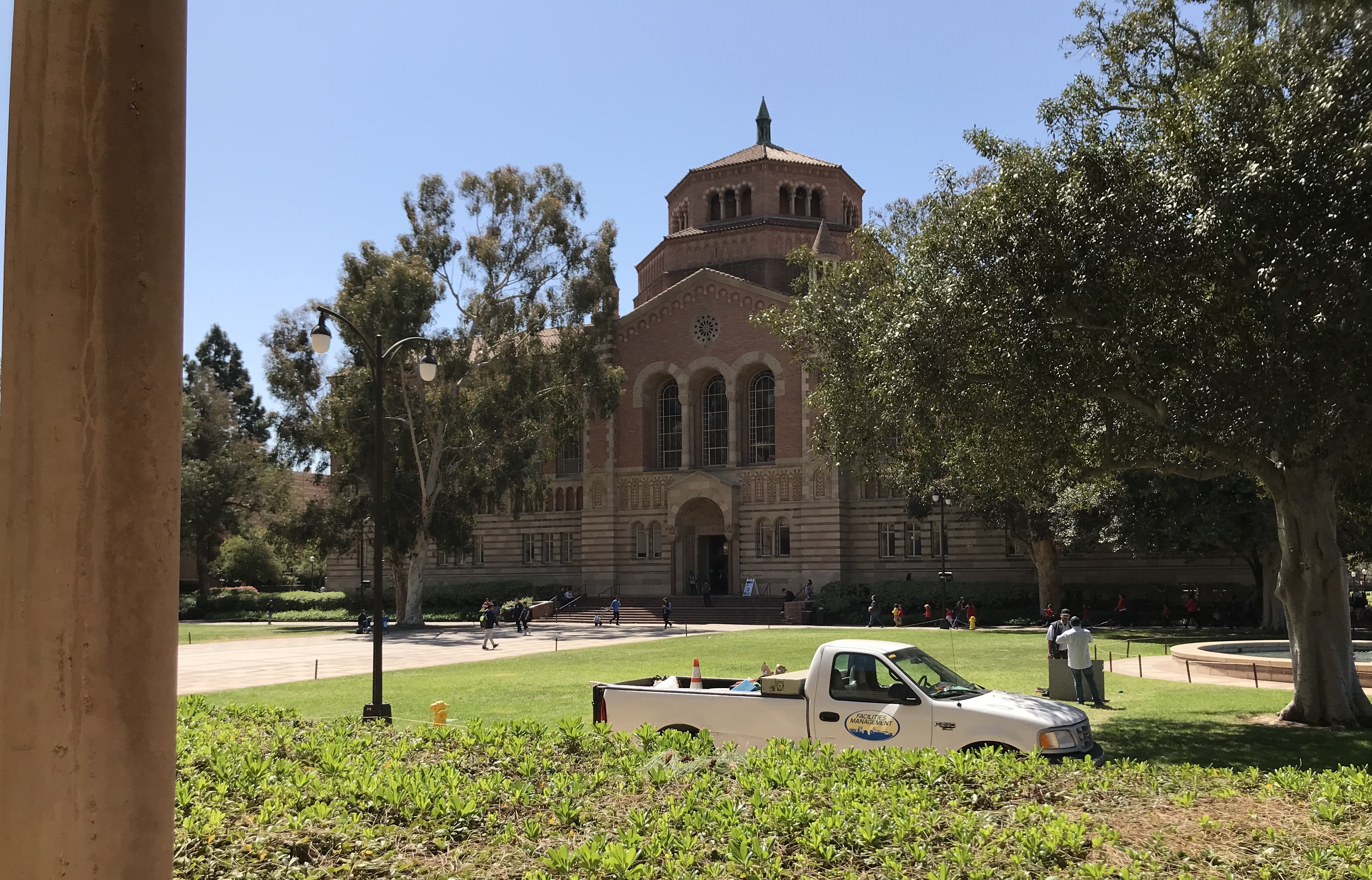
I next stopped by the Powell Library to charge my phone and wait for the Fowler to open. The library is a gorgeous building located directly across the quadrangle from Royce Hall. Both are modeled after the Basilica of Sant’Ambrogio in Milan.


There are quite a few libraries on campus, and as a huge fan of libaries, I will list them all: the American Indian Studies Center, Arts, ASUCLA, Center for African American Studies, Charles E. Young Research, Chicano Studies Research Center, Eugene and Maxine Rosenfeld Management, Gonda Family University Elementary School, Hugh & Hazel Darling Law, Institute for Social Science Research Data Archives, Instructional Media, Louise M. Darling Biomedical Library, Music, Rae Lee Siporin LGBT, Richard C. Rudolph East Asian, Science and Engineering, Southern Regional, and William Andrews Clark Memorial libraries; the Library Special and UCLA Library Digital collections; the Ethnomusicology and Television archives; and the Asian American Studies Center, Grace M. Hunt Memorial English, and UCLA Oral History Program reading rooms.
THE FOWLER MUSEUM
My phone sufficiently charged and the Fowler having by then opened, I headed back to the museum, checked my bag, and started exploring the collections.
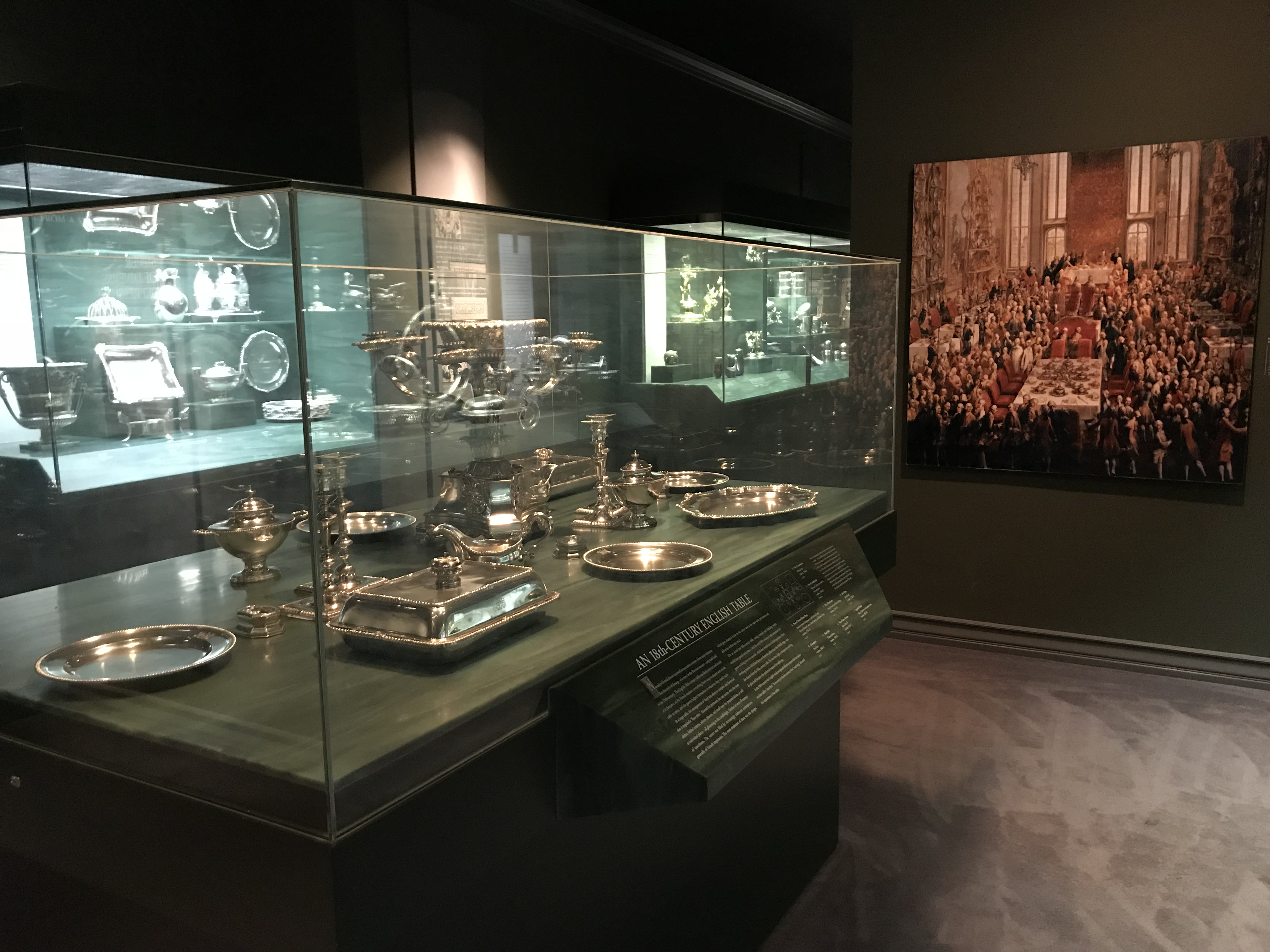
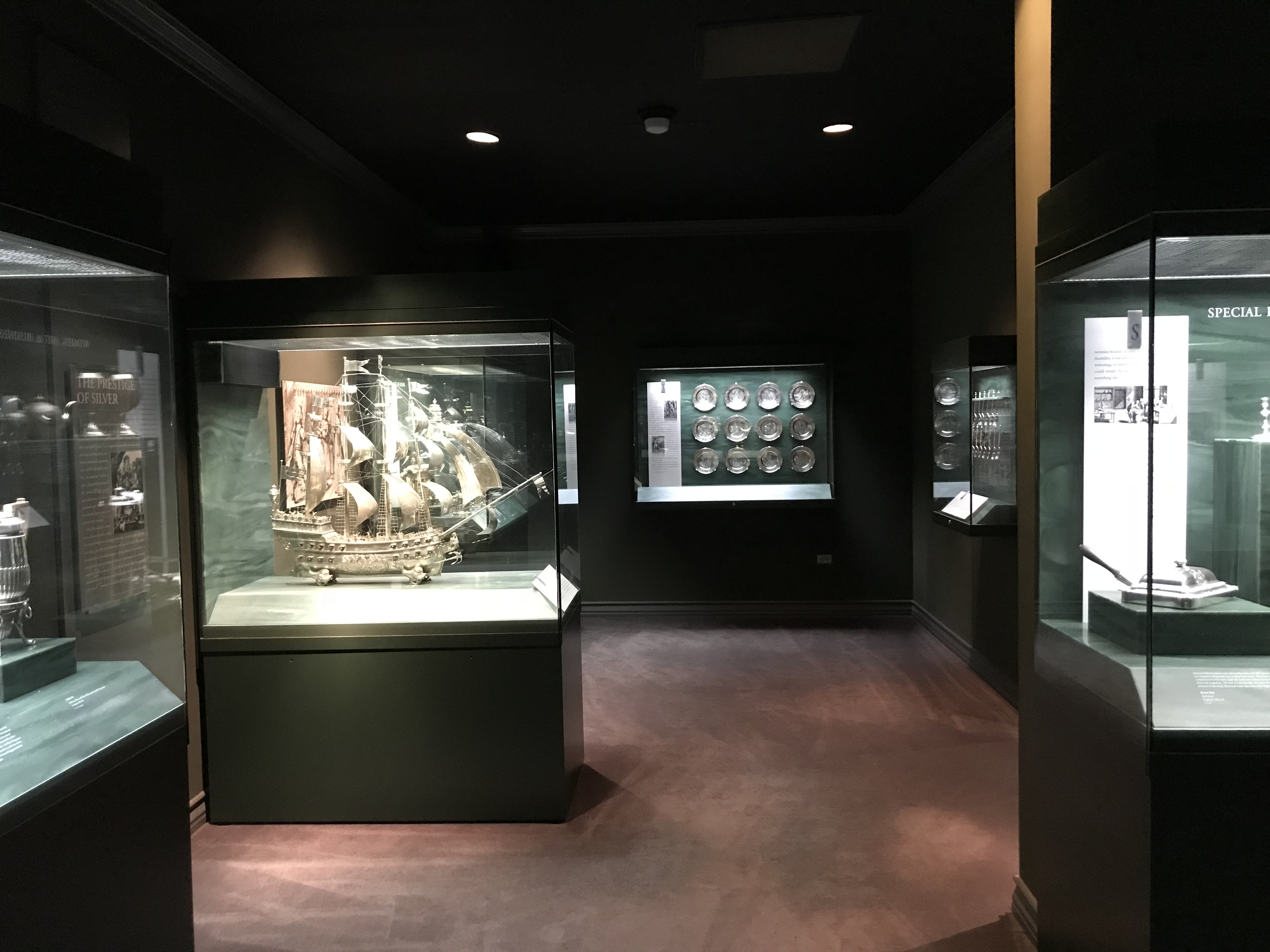
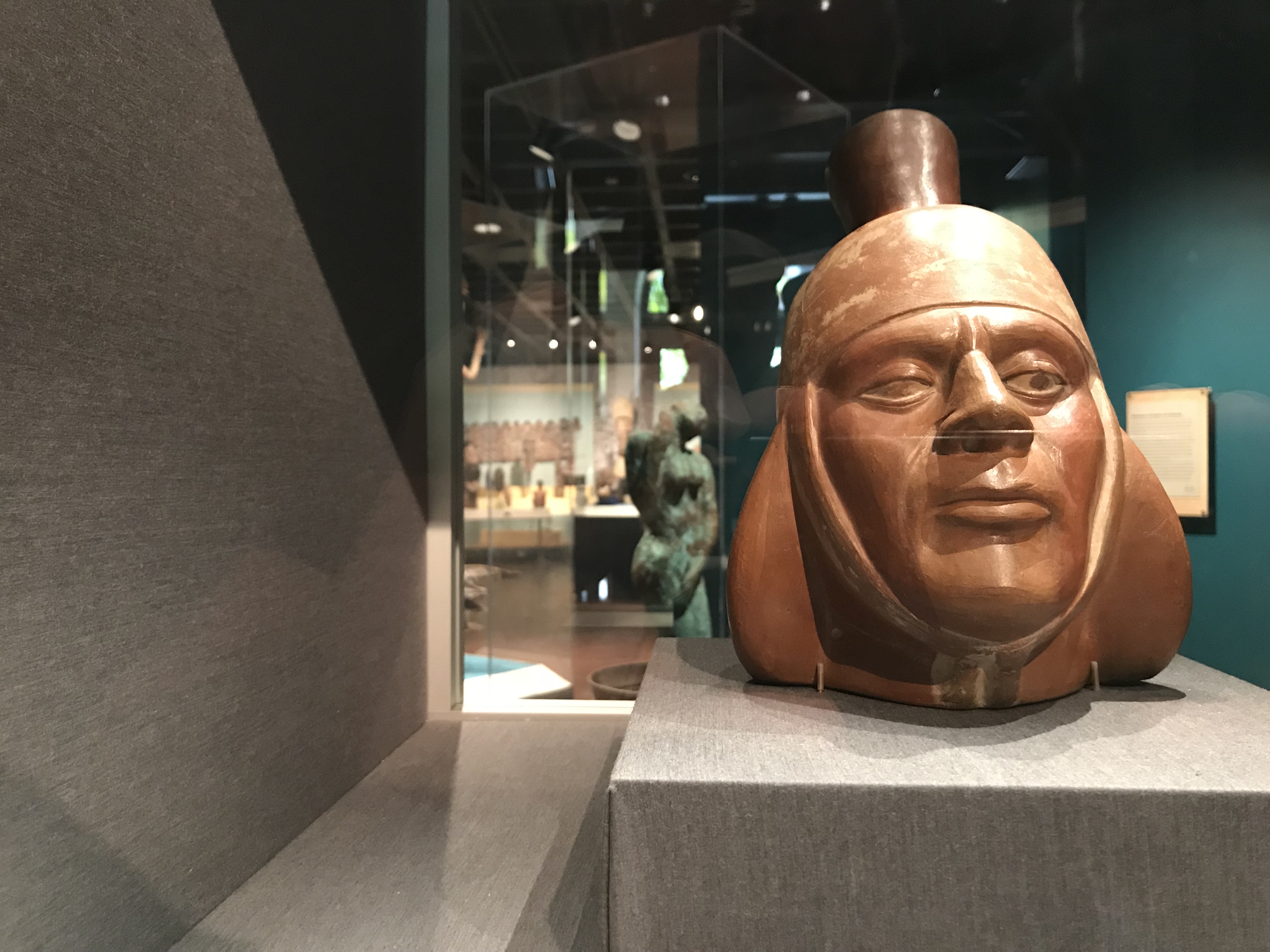
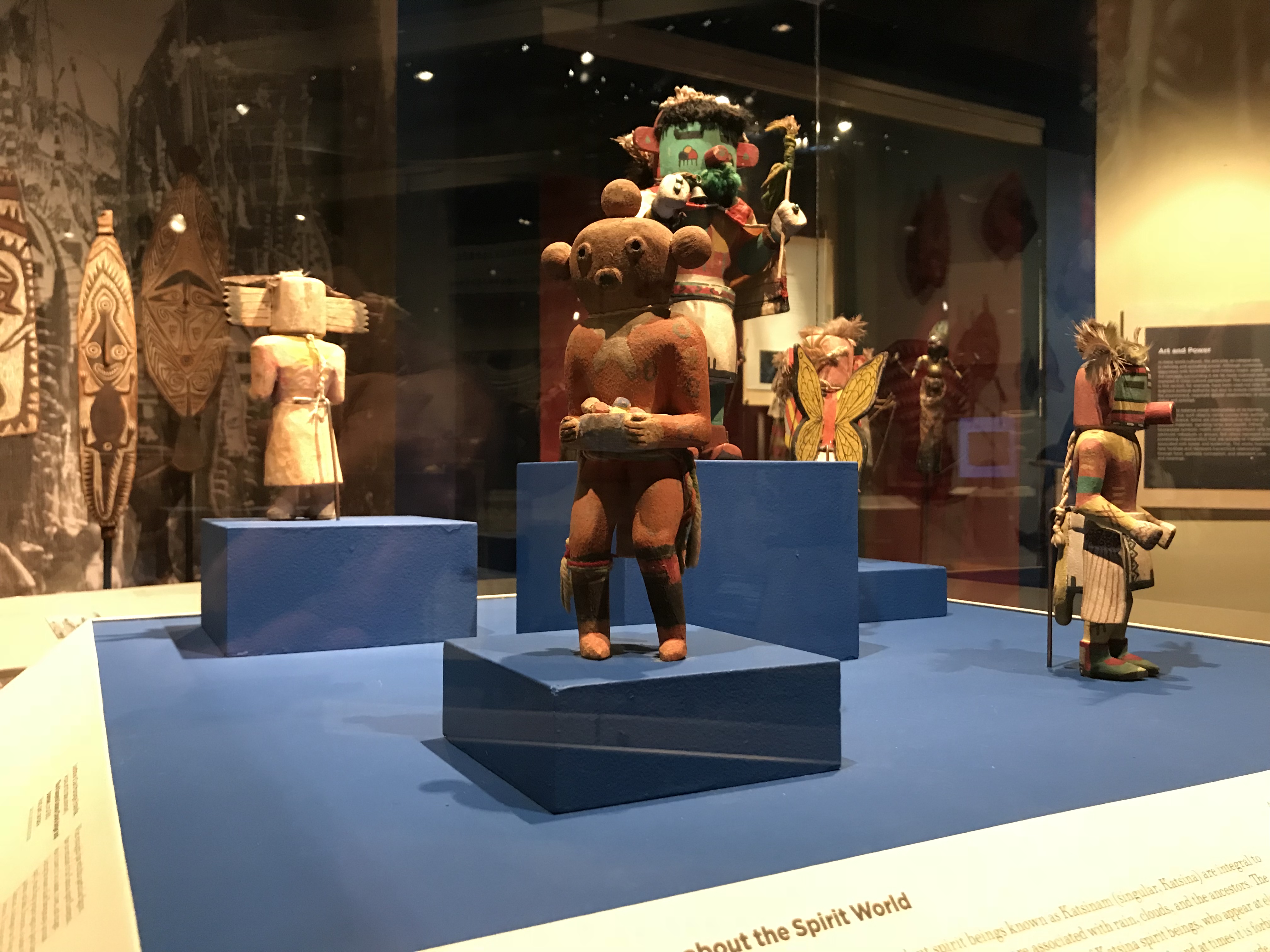
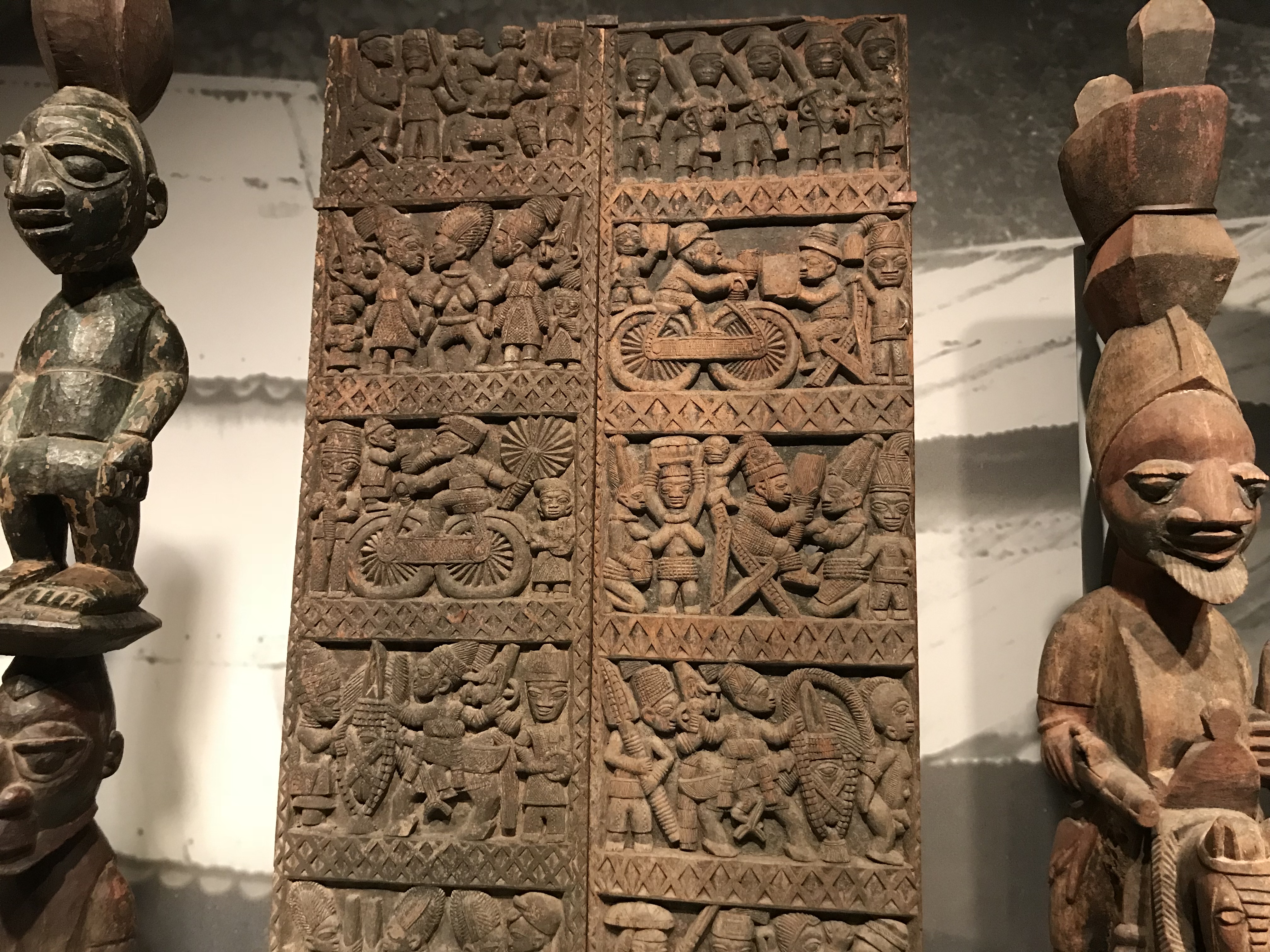
The Fowler opened in 1963 and is to my mind about the perfect size for a museum. I could easily spend about three to five hours in there but if you’re just looking for selfie backdrops and you skip reading any text, you could probably “do” the whole museum in under half an hour.
THE FRANKLIN D. MURPHY SCULPTURE GARDEN
Wishing to see as much of Westwood as possible, however, I moved on as soon as a noisy group of children arrived and headed for the Franklin D. Murphy Sculpture Garden.
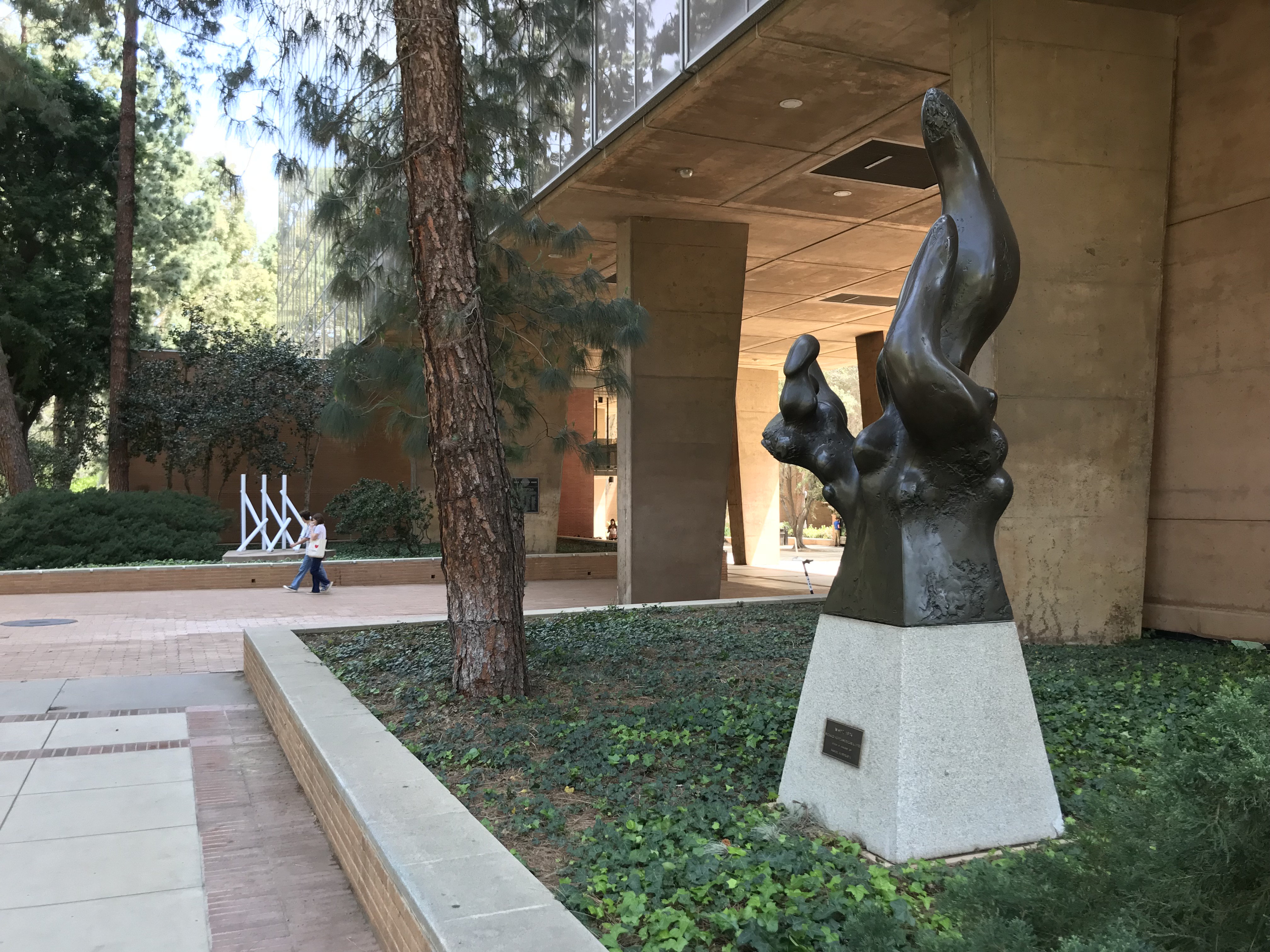
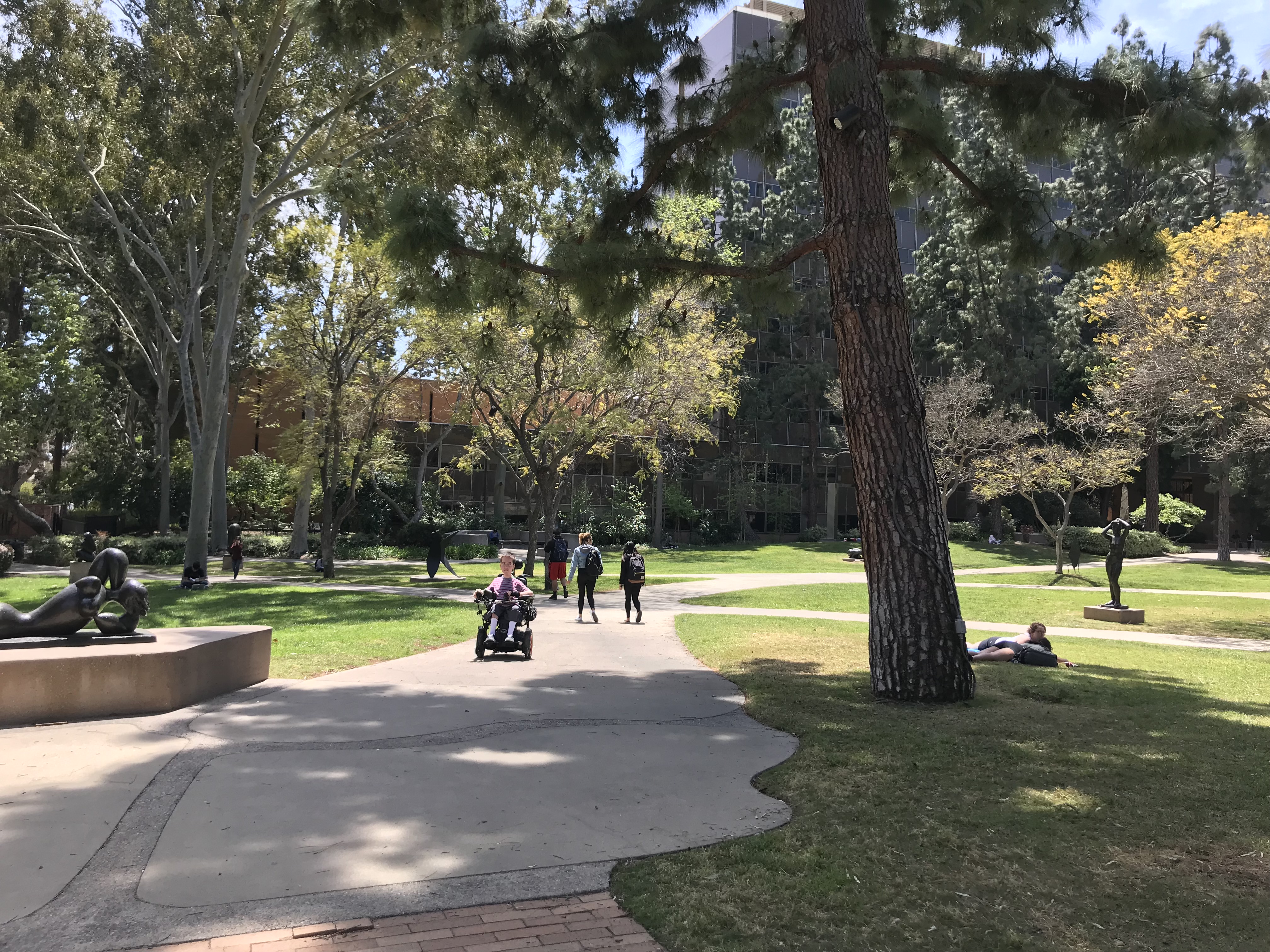
The sculpture garden features more than seventy sculptures by the likes of Alexander Calder, Auguste Rodin, Barbara Hepworth, David Smith, Deborah Butterfield, Hans Arp, Henry Moore, and Jacques Lipchitz — arranged throughout a two-hectare lawn. I could’ve easily spent more time there too but there were so many students relaxing here and there that I didn’t want to think I was approaching when in fact I just wanted to check out their headrests. Also, it was getting a bit warm for my liking so I next headed to the Geology Building.
THE UCLA METEORITE GALLERY

In the Geology Building, I asked the first person I saw for directions to the UCLA Meteorite Gallery. He was heading that way, it turned out, and he shared my excitement and told me about a meteorite the school is expecting to acquire soon. Some of the meteorites are absolutely beautiful, some impressive in size, but more awesome still is the fact that they came from places like the Moon, Mars, and the asteroid belt.
KLEINROCK INTERNET HERITAGE SITE AND ARCHIVE
Next to the Geology Building is Boelter Hall, where in room 3420, on 29 October 1969, at 22:30, UCLA student Charley Kline sent a message on the ARPANET using an Interface Message Processor (IMP) to an IMP at Stanford University, a feat now widely recognized as the birth of the internet. Today the room is known as the Kleinrock Internet Heritage Site and Archive (named after computer scientist Leonard Kleinrock, whose team Kline was part of). In 2008, graduate student Brad Fidler went looking for anything commemorating the birthplace of the internet and found nothing and thus he spearheaded the move to transform the site into a mini-museum and archive. Despite having an interest in nerd history (long ago I hastily co-organized an historic tour of Silicon Valley) it’s my firm belief that you have to save some things for later and at that moment I felt a pre-lunch forest bath was what I needed.
THE MILDRED E. MATHIAS BOTANICAL GARDEN



My final stop on campus was to the UCLA Mildred E. Mathias Botanical Garden. The garden is a 2.8-hectare feature named after named after botanist Mildred Esther Mathias Hassler. The landscape contains plants from aquatic, chaparral, desert, sub-tropical, and tropical climates and as such, there are scents both immediately familiar and completely exotic. Is impossible not to hear the beeping of service vehicles on campus and the din of automobile traffic on Hilgard Avenue, which is somewhat unfortunate because otherwise, it’s surprisingly tranquil. The garden closes at 17:00, which is also unfortunate, because I after rush hour ends and the sun begins to set it must be an amazing place to be.
Other features both students and non-students alike might want to check out on campus include the Inverted Fountain, the James Bridges Theater, the Macgowan Little Theater, Schoenberg Hall, and the Freud Playhouse. On a final note — the campus is very nicely landscaped, too, although I’m not sure who or what landscape architecture firm deserves credit.
WESTWOOD RESTAURANTS
I haven’t eaten in many Westwood restaurants before. The first place I ate was probably Native Foods Cafe, a vegan restaurant which has been around since 1994. A while ago, when I was still on a quest to find an Indonesian place I’d stumbled across earlier (which turned out to be Indo Cafe), I ate at Ramayani. More recently, when I was waiting for my passport to be processed. I ate breakfast at Novel Cafe. I try not to eat at the same place over and over but the restaurant scene at Westwood Village always leaves me frustrated and even a bit grumpy. How can the restaurant options in shopping and entertainment district in one of the world’s preeminent food cities so closely resemble those of a suburban outlet mall’s food court?
There are so many un-inspiring multinational chains in Westwood Village. That’s not to say that there are no good options, but really — who is Jersey Mike’s for? Soliciting recommendations from friends, I was told to go to Stan’s Donuts, Saffron & Rose, and Diddy Riese. I’m really not that picky but I don’t have much of a sweet tooth and even if I did, I wasn’t keen on a hearty lunch of donuts, ice cream, and cookies. There were also recommendations for Attari Sandwich Shop, in Tehrangeles — but I find that neighborhood to be worthy of its own California Fool’s Gold episode so I didn’t really spend much time over there.
There actually are quite a few restaurants spread throughout the entire Westwood region and for the sake of completism they include Ami Japanese Restaurant, AMMO at the Hammer, Arian Lounge, Asuka, Bab Alhara, The Backyard, Barney’s Beanery, BBQ Chicken, Bella Pita, Bibigo Fresh Korean Kitchen, Bites, Bollywood Bites, Bomb Shelter, Bombshelter Bistro, Bruin Cafe, Bruin Plate, Cafe 50’s, Cafe Chez Marie, Cafe Glace, Cafe Med, Café 451, Café 1919, Café Synapse, Carmine’s Restaurant & Bar, Casa Del Norte, CAVA, Cilantro Fusion Grill, Clementine, Cork And Tap Beer And Wine Bar, Corner Bakery Cafe, The Corner Deli & Grill, Covel Commons Residential Restaurant, Cravings, D1 Cafe, A Delphi Greek, De Neve Commons Residential Restaurant, De Neve Late Night, De Neve Restaurant, Dina’s Cafe, Double Take, Dyllan’s Deli, D’Amore’s Famous Pizza, 800 Degrees Neapolitan Pizzeria, Elysee Bakery & Cafe, Emporium Thai, Enzo’s Pizzeria, Falafel King, Fatburger, Fat Sal’s Deli, Feast At Rieber, Fire Hook Taco Truck, First Szechuan Wok, The Flame Broiler, Flame Persian Cuisine, Foodism, Fresh Corn Grill, Frida Mexican Cuisine – Westwood, Fundamental LA, Fusion, Greek Pizza, The Greenhouse, Gushi, Gypsy Cafe, Habibi Cafe, Hamasaku, Headlines Diner & Press Club, House of Meatballs, Ike’s Place, Il Tramezzino, Italian Express, James’ Garden Cafe, Japadog, Jimmy John’s, Jin Jiang Restaurant, Johnnies, KazuNori | The Original Hand Roll Bar, Kikka, The Kitchen At Westwood, Koala T Café, La Bruschetta Ristorante, Lamonica’s New York Pizza, Le Pain Quotidien – Los Angeles, Lina’s Express, L Kitchen, Lucia’s Cafe, Madison’s Neighborhood Grill, Maharaja Cuisine of India, Mary & Robb’s Westwood Cafe, Media Services Cafe, Mesa Brazilian Eatery, Mexican American Grill & Deli, Miranda’s, Mon Amour Cafe, Mr Noodle, Musashiya Udon Noodle, Naab Cafe, Napa Valley Grille, Nathan’s Kosherland, NineThirty, Northern Cafe, Northern Lights Cafe, Nushii, Onkei Ramen & Sushi, Pacific Rice & Noodle Traders, Palomino, Panini Cafe, Pauley Pavilion Food Court, Pieology Pizzeria, Pinches Tacos, Pita Cafe, Pizza Fresca, Plateia, Poke Bar, Pomodoro Trattoria, P’tit Soleil, Qin West Chinese Cuisine, Ramen Fujiwara, Rendezvous, Roadside Grill, Rocco’s Tavern, Ronald Reagan UCLA Medical Center – Cafeteria, Rubio’s, Salad Farm, SanSai Japanese Grill, SEAS Cafe, Sepi’s, Seventy7 West, The Shack at Hillel, Shaherzad, Shamshiri Grill, Sholeh, Simplethings, Skylight Gardens, Smith & Cohen, Smith House Tap & Grill, Soleil Westwood, SpireWorks, Sprazzo Cucina Italiana, Sproul Dining, Stage Canteen, STK Los Angeles, Sunnin Bakery, Sunnin Lebanese Cafe, Sweetfin Poké, Take Five, Tanino, Tender Greens, Thai Fresh Cafe, TLT Food, Tochal Market, Tombo Japanese Restaurant, Tommy Taco, Tomodachi Sushi, Trimana, Trimana, The Tuck Room Tavern, The Tuck Room Tavern, UCLA Medical Center Cafeteria, Veggie Greek, Veggie Grill, Viet Ngan’s Lab, Westwood Pizzeria, Westwood Thai Cafe, and Wolfgang Puck Express.
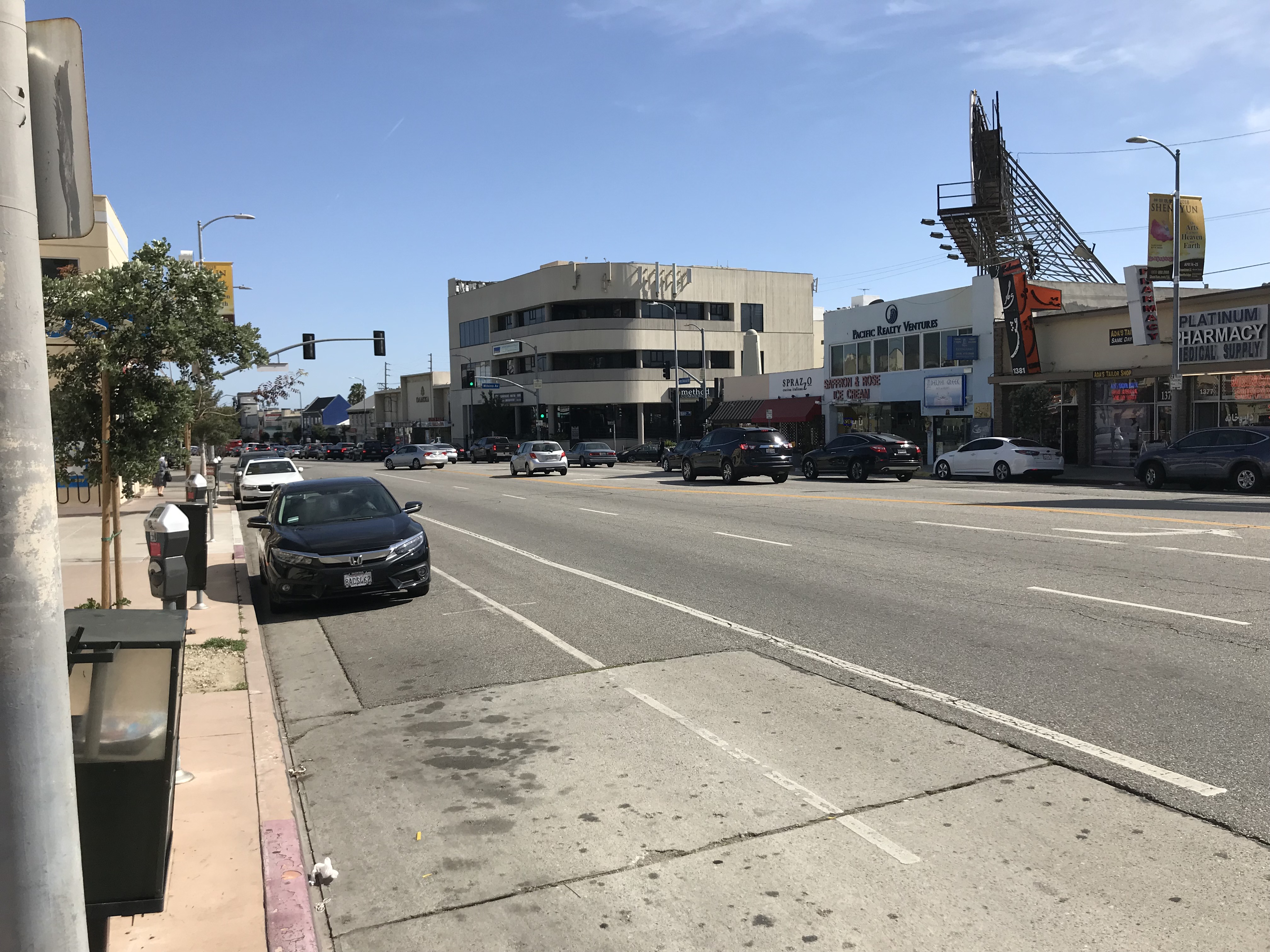
I weighed my options and decided to check in with my taste buds. I realized that a beer or two would be nice after having trekked around for about five hours — which reduced my dining options quite a bit. I also, whenever possible, avoid televisions in restaurants which reduced my options even further. In the end, I ended up going once again to Native Foods. Pulp was playing over the speakers, instead of sports coverage, which was reassuring. There I had two beers and a vegan double cheeseburger before venturing back out to explore the Village and Golden Mile before heading home.
WESTWOOD VILLAGE

Currently, the most interesting thing about Westwood Village is the architecture. The icon of the village, the Janss Investment Company Building, was designed by Allison & Allison and completed in 1929. Like most of the village’s original structures, it’s in the Mediterranean Revival–style. The Janss brothers, Harold and Edwin, handpicked the district’s first 34 businesses. By 1939, there were 452 businesses and it was a bustling shopping and cinema district. I’m not sure what those original businesses included, but suffice to say they must’ve been more inspiring than what you find there now. Those businesses include phone service shops, shippers, convenience stores, vape shops, and a place called Scrubs Unlimited. I’m not saying that they serve no purpose but most are the sorts of places one visits whilst running errands rather than the sort of places which invite people to visit an explore a neighborhood.
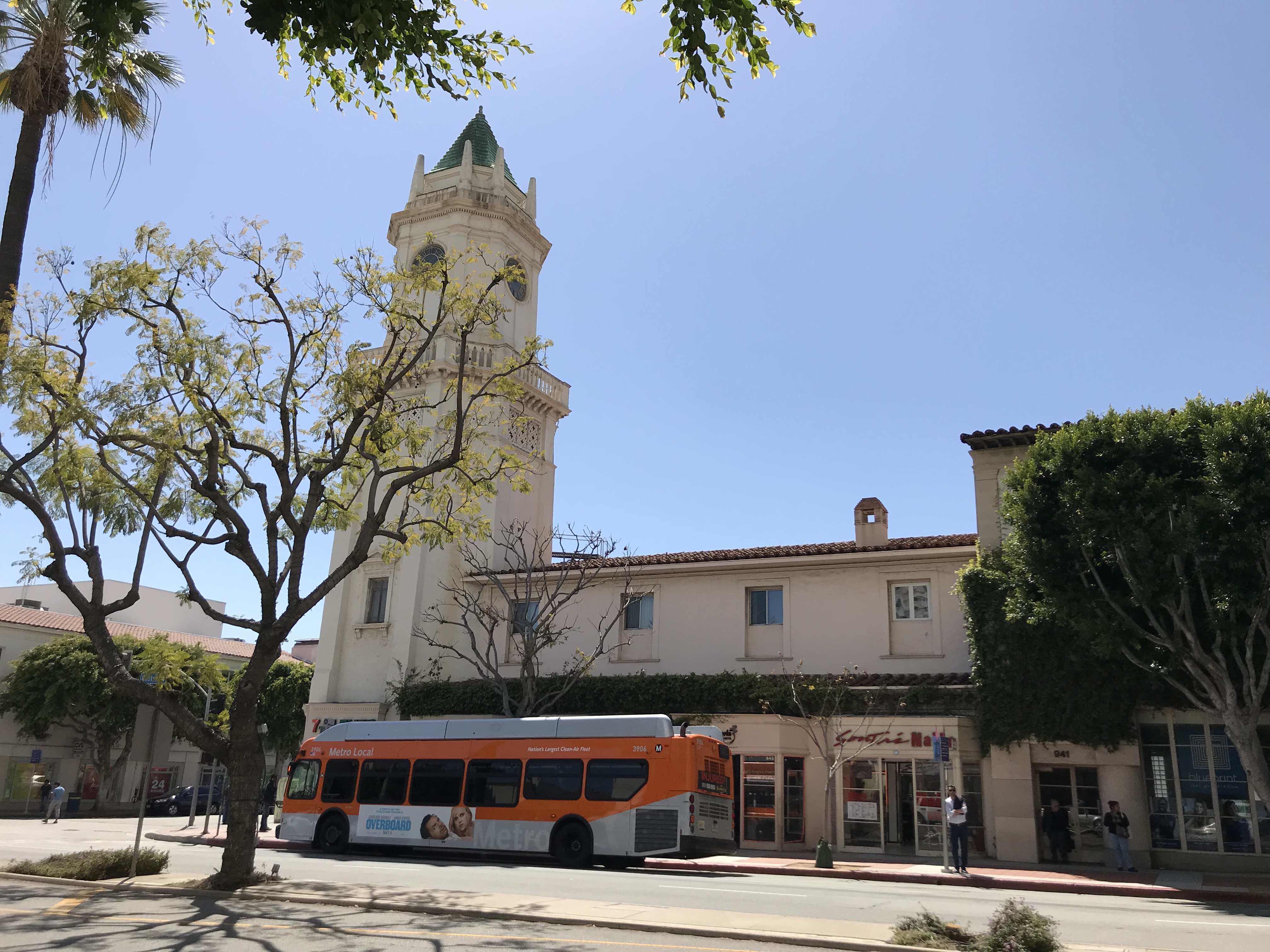
Holmby Hall was designed by Gordon Kaufmann, John and Donald Parkinson and built in 1929. It was the first commercial building constructed in Westwood Village and was also used as a dormitory for female students. A 2003 fire damaged the upper stories but it looked to me to be in pretty good shape — although I purposely waited for the moment a Metro bus would block out the ground floor 7-Eleven.

The Kinross Cornerstone (aka Shepard Mitchell Building), is a Spanish Colonial Revival-style building designed by Stiles O. Clements and built in 1930. It was one of the original buildings of Westwood Village. It’s situated next to one of the many under-utilized alleys which criss-cross the Westwood Village neighborhood.
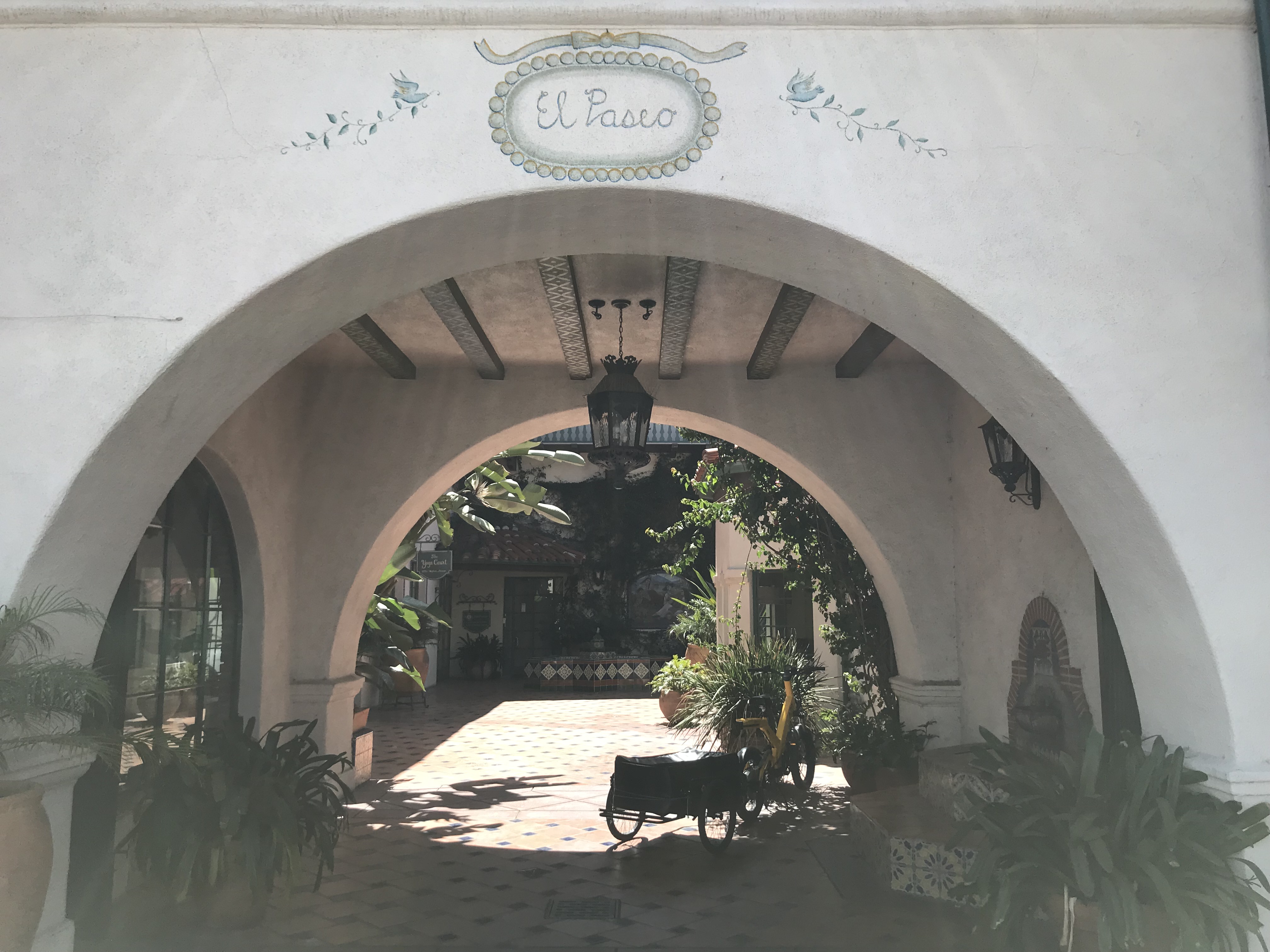
The Spanish Colonial Revival El Paseo Building was designed by Norstom & Anderson, built in 1932, and has a nice patio. One of its tenants is California Pizza Kitchen.
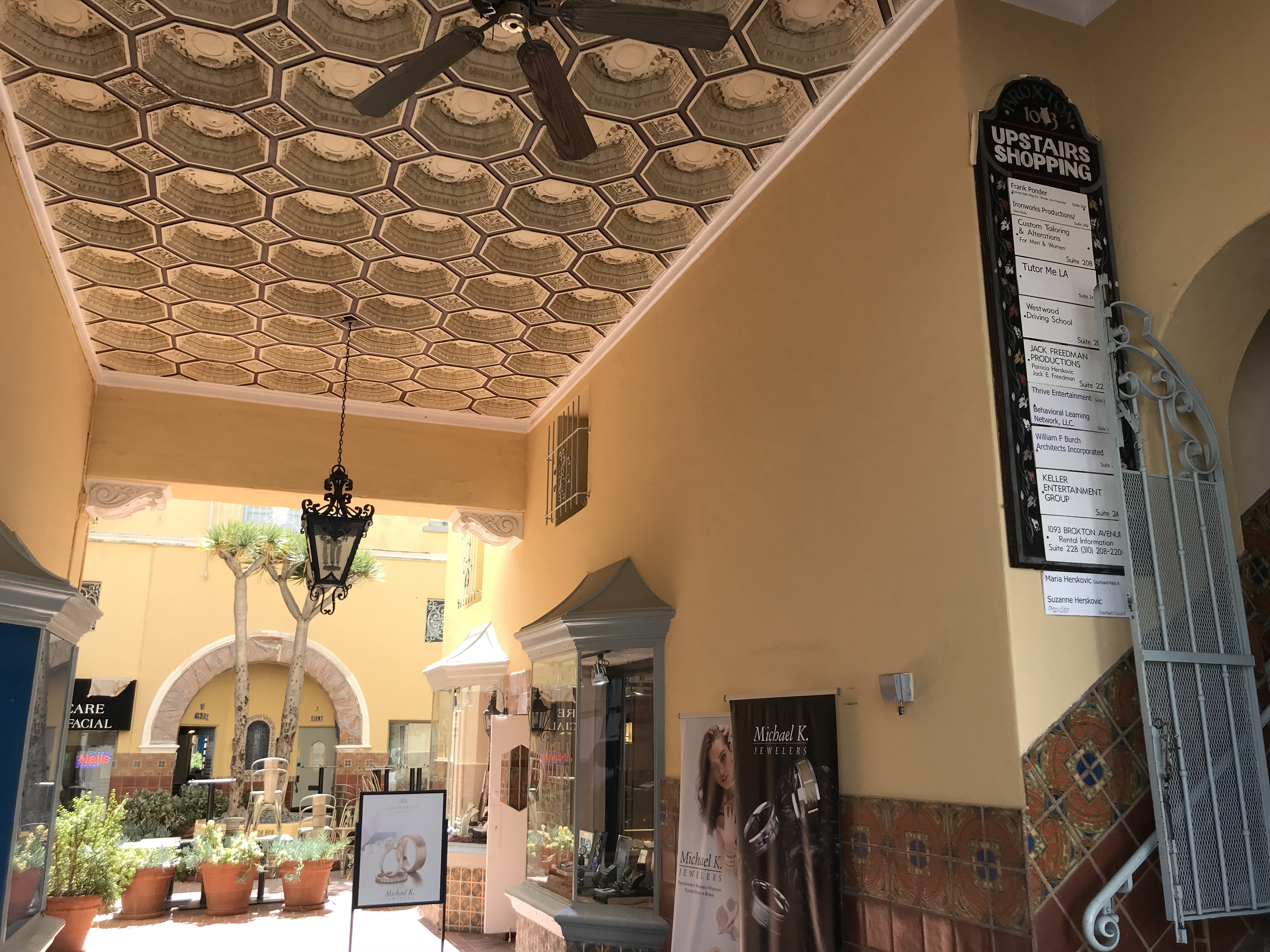
The Mediterranean Revival University Professional Building, built in 1929, also has a nice patio. However, when tenants include a driving school and a Verizon store, there’s not much reason to hang out there.
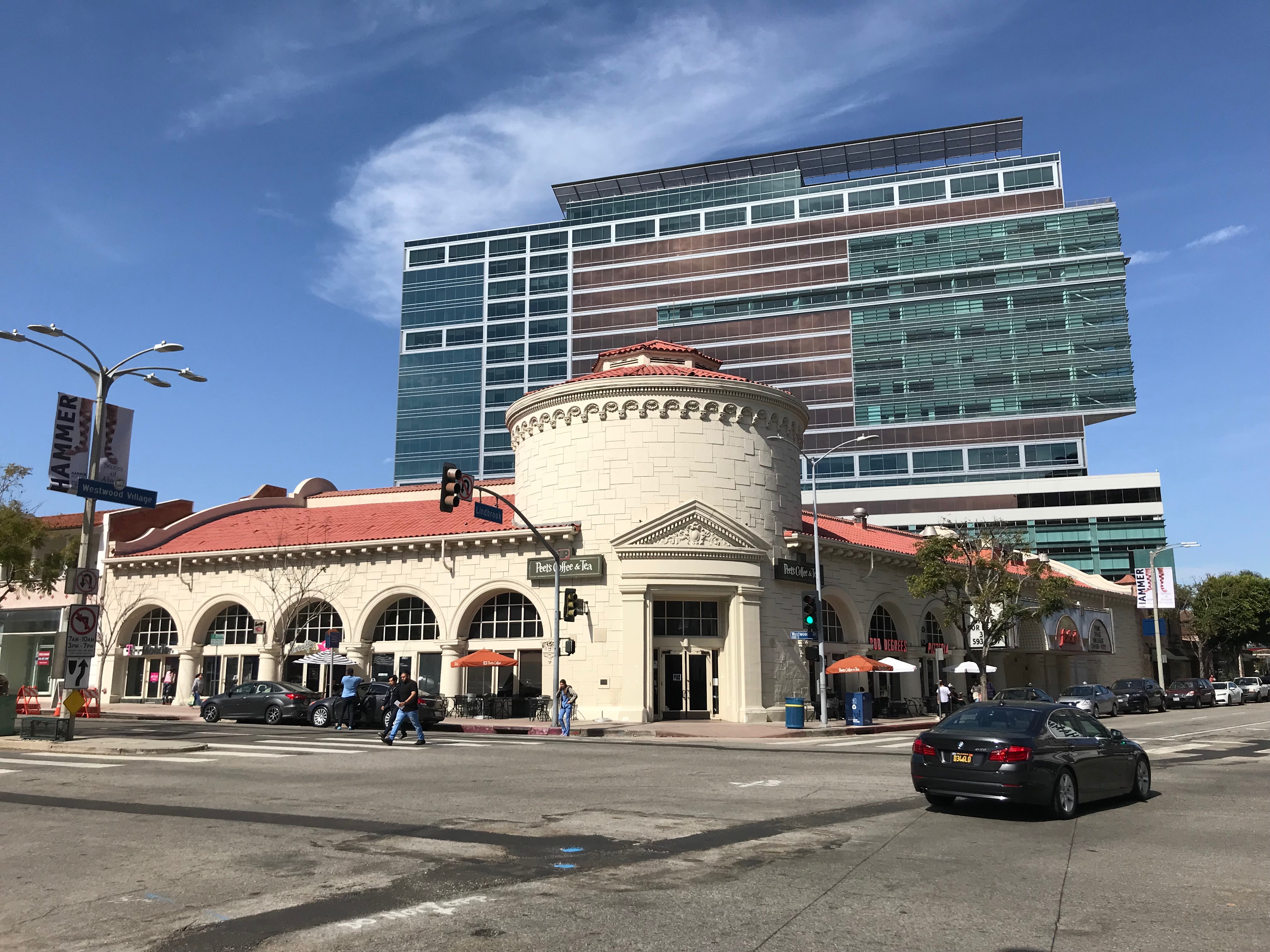
The old Ralph’s building was designed by Russell Collins and built in 1929 for Ralph’s Grocery Store. Ralph’s moved around the corner in the mid-1960s and 1970, it became the 560-seat Festival Theater. It was later remodeled by United Artists Theatre Circuit as the UA Egyptian and in 1988, the Odeon Cinema. The building was added to the National Register of Historic Places in 1992. The cinema closed in 2009 and the space is now occupied by a location of Peet’s Coffee & Tea.

Many of the most striking buildings in Westwood Village are, or were at one time, cinemas. Arguably, the most impressive is the grand, 1,341-seat, neon-lit, Mission Revival-style Village Theatre, which opened on 14 August 1931 with a screening of the Norma Shearer vehicle, A Free Soul. It was later taken over by the Fox West Coast Theatre chain and became known as the Fox Theatre although the Mann Theatre chain took over from Fox West Coast and in 2010, the Regency Theatre chain took over from Mann. Today, as is the case with all of Westwood Village’s theaters, the cinema mostly screens first-run, commercial American films.
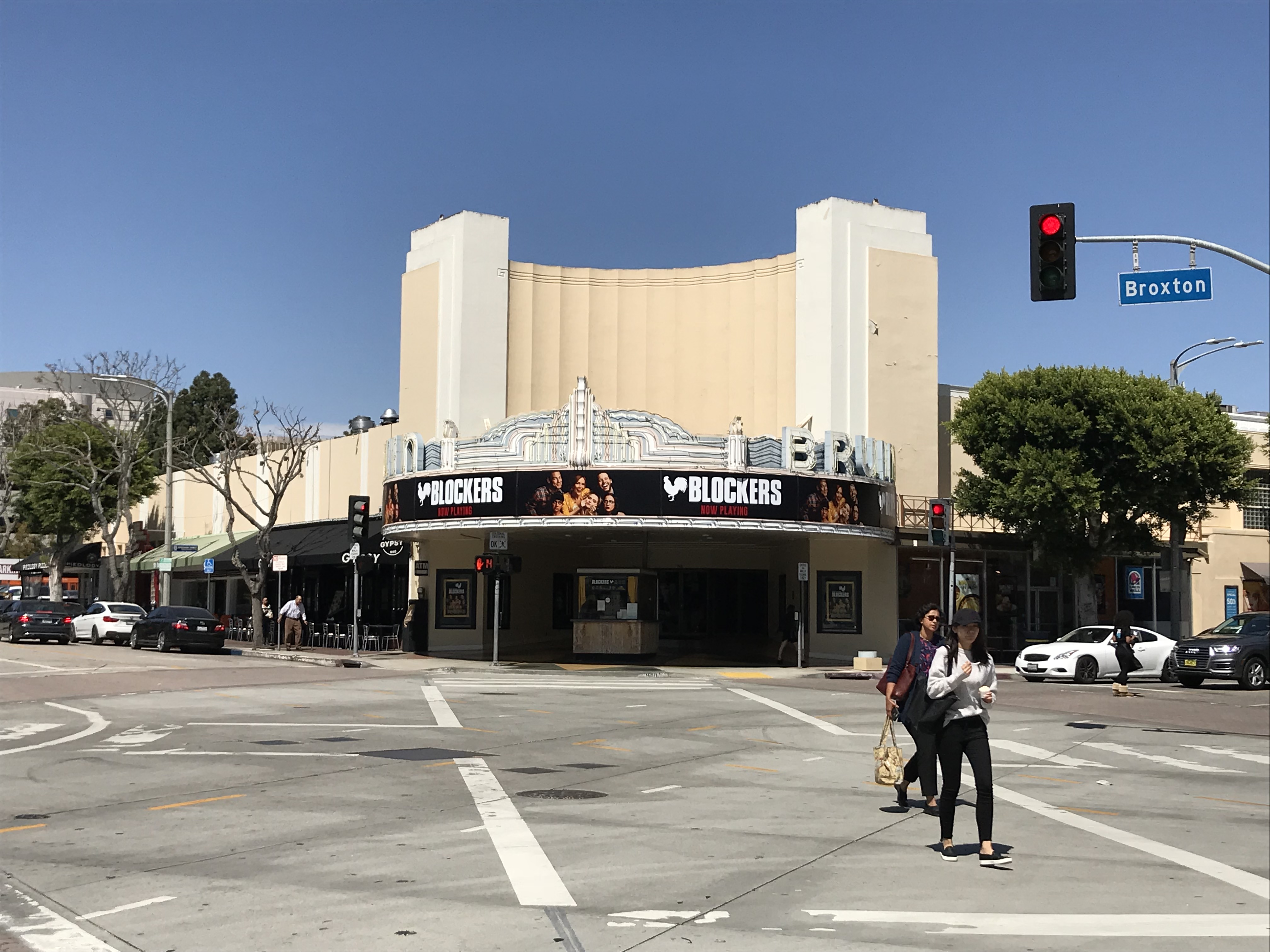
Across the street from “the Fox” is the Bruin Theatre, which opened on the last day of 1937. The Streamline Moderne-style cinema was designed by the prolific Simeon Charles Lee. Originally operated by Fox, it was taken over by Mann in 1973. Sadly, at some point, a series of glow-in-the-dark murals were painted over. In 2009, it was taken over by Regency.

A bit south of Westwood Village is the 460-seat, Streamline Moderne Crest Theatre, designed by Arthur W. Hawes and originally a live venue known as the Westwood Theatre, which opened in 1940. A few years later it was acquired by the Dietrich & Feldstein, who converted it into a cinema. It has been renamed several times, including UCLAN Theatre, Crest Theatre, Metro Theatre, Crest Theatre again, Majestic Crest Theatre. It is currently closed and for sale.
MORE WESTWOOD CINEMAS
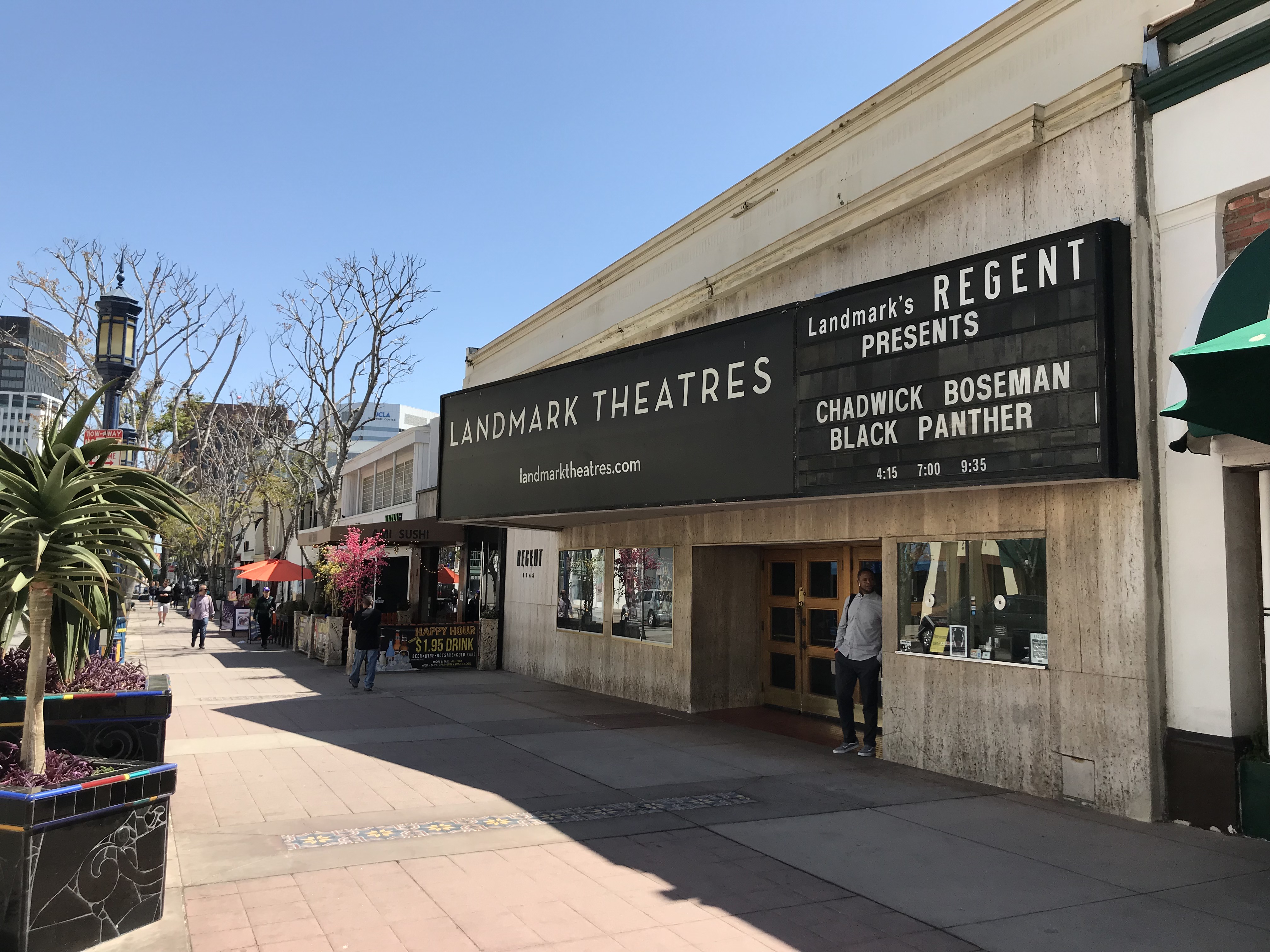
The 400-seat Regent Theatre was opened in 1966 by the Laemmle Theatre art-house chain. The building was constructed in the 1940s for retail and later, the lobby was reabsorbed into one of the neighboring businesses. In the 1970s, Mann took over operations of the cinema and used it as a second-run theater. In 2002, Landmark Theatres took over. Despite its reputation as an arthouse chain, it also screens Hollywood blockbusters and cult films including, famously, Tommy Wiseau‘s The Room.
The six-screen AVCO Center Cinemas also opened in 1972. It closed in 2011. In 2012, it was purchased by iPic Entertainment and reopened in 2014 as the iPic Westwood. The films they show are standard, wide-release commercial American films. However, with reclining seats, valet parking, food and beverage service, it looks suspiciously like Tim Heidecker’s Six Bag Cinemas. I give it five bags of popcorn and a big bottle of truffle oil.
The James Bridges Theatre is the UCLA Department of Film, Television and Digital Media‘s main screening location. It opened (I believe) in 1999 and prior to the opening of the Billy Wilder Theater in 2006, the 278-seat theater was the official venue of the UCLA Film & TV Archive. The theater was extensively renovated in 2003 and today often includes in-person appearances from film casts and academics.
The 295-seat Billy Wilder Theater opened in the Hammer Museum in 2006, as the official venue for the UCLA Film & TV Archive (the second largest film and television archive in the country after the Library of Congress). The theater doesn’t just screen a wide range of films but also hosts concerts, conversations, lecturers, and readings.
THE TAIWAN ACADEMY
The Taiwan Academy in Los Angeles opened in 2014 with the noble aim of promoting Taiwanese arts and culture. Originally it mostly did so by screening free Taiwanese films by directors including Arvin Chen, Doze Niu, Huai-en Chen, Peter Tang, Tso-chi Chang and the blockbuster Cape No. 7. There were also rumors that pizza was sometimes served and there was also talk of upcoming screenings by a giant of New Taiwanese Cinema, Hou Hsiao-hsien, and leading light of the Second New Wave, Tsai Ming-liang. In short, I was imaging a Taiwanese counterpart of the Korean Cultural Center but I should’ve known better as Taiwanese culture hasn’t been promoted nearly as savvily as has Korean culture. When I crossed town to visit the academy, I found that the focus had shifted away from film toward conceptual art… and there was no pizza.
I know I’m getting away a bit from my account of exploring of Westwood here but as a bonafide lover of Taiwan, I’d like to humbly offer some suggestions to the Taiwan Ministry of Culture. Ideally, the Taiwan Academy should inhabit a larger space — such as the currently empty Festival Theater. A space like that, with a stage and screen, could be used to showcase all manner of Taiwanese arts. It would be nice to see works by highly regarded filmmakers like Edward Yang, popular older filmmakers like King Hu (everyone loves wuxia), and up and coming filmmakers from both Taiwan and the Taiwanese diaspora. Same goes for music and performance — I would happily cross town to see a glove puppetry show or music performance. Ideally, as I see it, the music would include aboriginal folk, Chinese traditional music, and current Taiwanese acts like Alex Zhang Hungtai (Dirty Beaches), Cheer Chen, Deserts Chang, Joanna Wang, and Tizzy Bac. Finally — far be it from me to dissuade the serving of free pizza but it seems to me that Taiwan’s brand could benefit a great deal from acknowledging that most Angelenos love Taiwanese — even if they aren’t aware that what they’re eating or drinking is Taiwanese. There are still many people who honestly think that Mongolian barbecue (蒙古烤肉) is actually Mongolian. A local website incorrectly referred to Pine & Crane as a Thai restaurant. I’d wager that most non-Taiwanese who eat at Din Tai Fung are somehow unaware that it’s a Taiwanese chain. I’d love to see Taiwanese concessions sold at the academy like boba, cheese tea, moachi, baobing, and Taiwan Beer. I’m afraid there isn’t a strong enough ventilation system in the world to make serving stinky tofu indoors a viable idea — so maybe prepare and serve that outside.
SKYSCRAPIFICATION & THE GOLDEN MILE
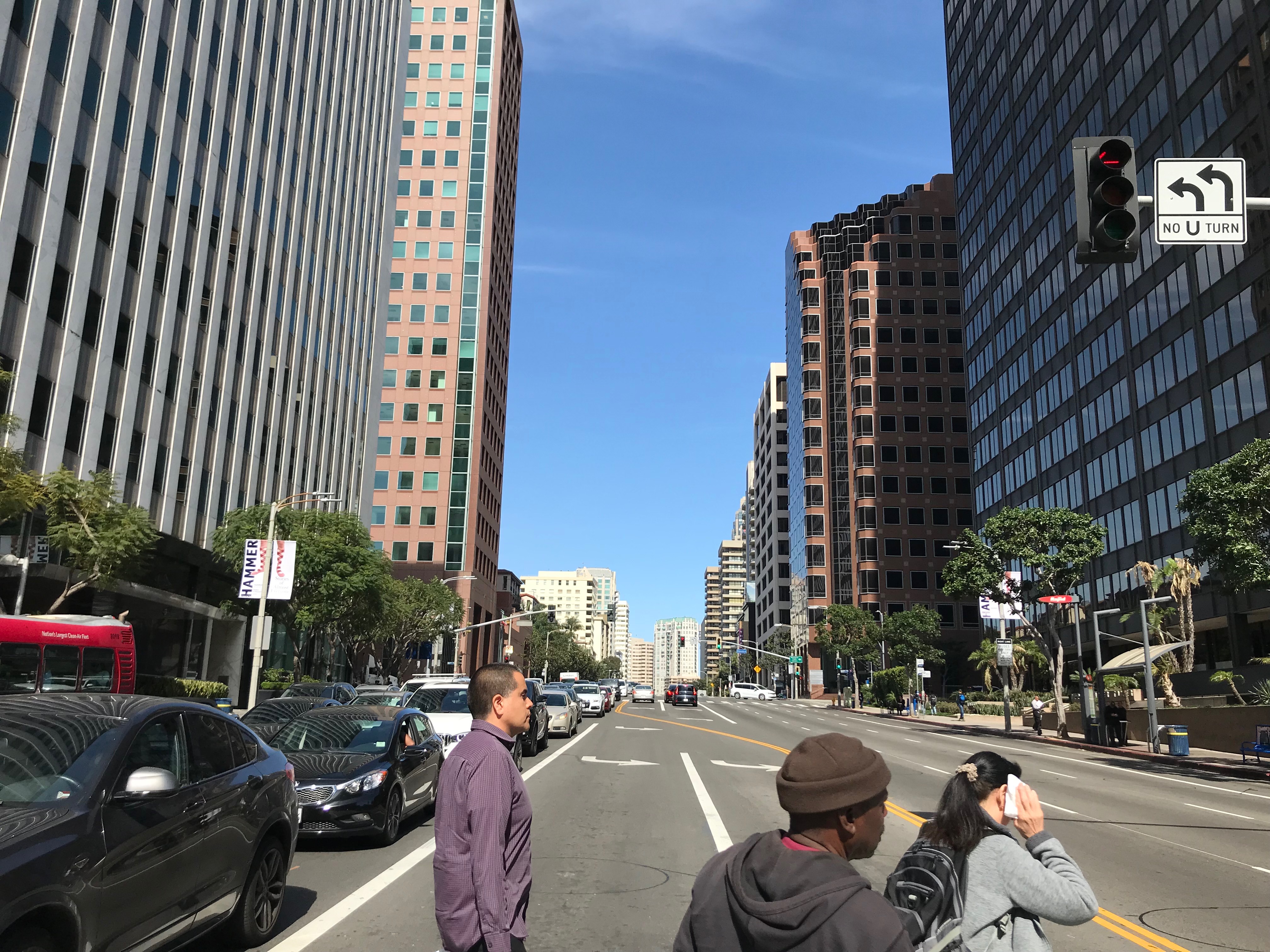
Fans of high-rises will also find many in Westwood — which is kind of surprising considering the fact that a chorus of hysterical complaints erupts across the Westside anytime an architect even dreams of building something more than four stories tall. Although the NIMBYS inevitably protest “Manhattanization!” If anything, the high-rises along the Wilshire Corridor (colloquially known as “Golden Mile”) prove that it takes more than multi-story buildings to make a Manhattan. Since the first time I passed through the neighborhood, almost twenty years ago, the empty sidewalks of Millionaire Mile have filled me with an unshakeable melancholy.
When I think of Manhattan, I don’t so much think of skyscrapers (Manhattan is hardly Hong Kong) as I do sidewalks filled with people, subways filled with people, and bars filled with people until 4 in the morning. The Golden Mile has none of those things. There is no sense of vibrancy here. I’ve walked the entire length of the corridor several times and on most occasions, the only other souls I encountered were doormen, groundskeepers, valets, and the occasional tight-lipped tenant stepping cautiously into the harsh light of day just long enough for their tiny dogs to poop on the grassy road verge. Afterward, they invariably scuttle back inside their hermetic high-rises. There are no businesses in the Golden Mile aside from a handful of houses of worship. It is not Manhattan, it is not Hong Kong — it is a Chinese ghost city transplanted from some remote province to the Westside. It is aggressively bleak — and like most things aggressively bleak, there’s somehow something inexplicably appealing about it.

The oldest off-campus high-rise is 10401 Wilshire Building, built in 1951. The residential Wilshire Terrace Co-Op, constructed in 1958, was the first building in Los Angeles to receive its construction permit after the thirteen-story height limit was lifted. They were followed by 10787 Wilshire Blvd (1962); Wilshire Holmby Condos and the Wilshire Regent (both 1963); and Wilshire-Comstock Building 1 & 2 (1964 and 1966).

It was the 1970s, though, in which the so-called Wilshire Corridor really began to rise. The 24-story Oppenheimer Tower opened in 1970 and was featured prominently in the 1978 Emergency! episode, “The Steel Inferno.” It was followed by 10960 Wilshire Boulevard (1971); Crown Towers, Wilshire Selby (West and East), and Doubletree LA Westwood (all 1972); the Westholme (1976); Sterling International Tower (1977); Wilshire Marquis (1978); and the Longford/10790 Wilshire Boulevard (both 1979).
The 1980s saw the rise of the Grand and the Westford (both 1980); Murdock Plaza and UCLA Wilshire Center (both 1981); the Diplomat, the Evian, the Mirabella, Regency Wilshire Condominiums, the 10560 Wilshire, the Wilshire Thayer (all 1982); Wilshire House (1984); Westwood Gateway One (1985 — followed by Two and Three in 1989); One Westwood (1987); Westwood Place (1988); and the Dorchester, Park Wilshire Condos, and the Tower (all 1989).
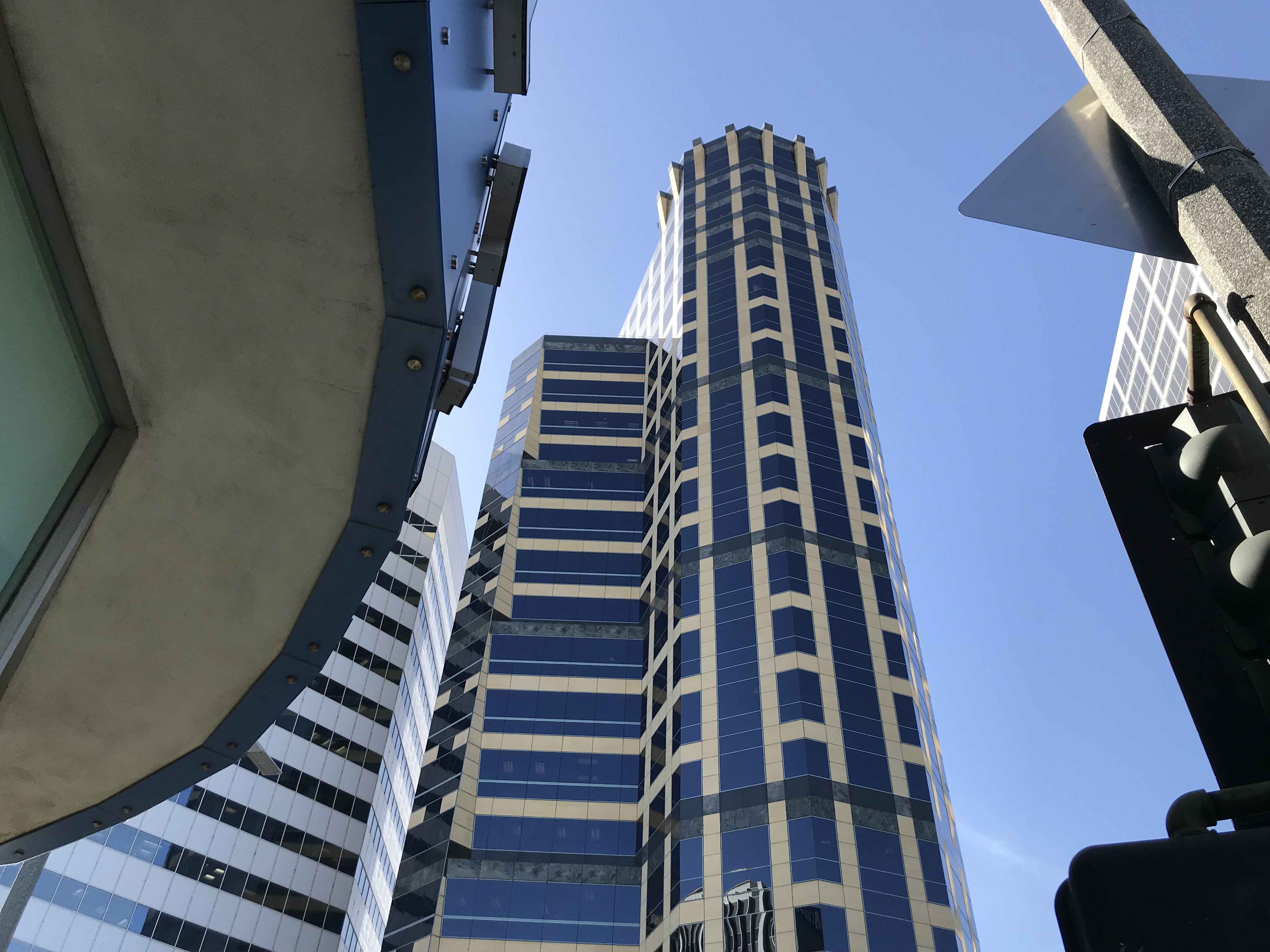
Among the more architecturally notable is the Tower, a Postmodern-style high-rise designed by architect Helmut Jahn of the Chicago firm Murphy-Jahn. By the 1990s, most of the properties had been developed, but Center West and the Wilshire (1990), La Tour (1991), and Nextel Building (1994) all rose. The 2000s also brought few highrises, just the Remington Condominiums (2000); Californian on Wilshire (2003); and the Beverley West Residences and The Carlyle Wilshire (both 2009). No new towers have risen in the 2010s but it being well into the 21st century, they should probably have retail on the bottom floor(s).
HOUSES OF WORSHIP
Most of the interesting buildings along the Golden Mile are religious temples. I’m not religious although I enjoy, sometimes, religious architecture and admire the community spirit that houses of worship ideally foster. That said, I’m not sure how such community spirit fares when in overshadowed by the imposing isolationism of the neighboring ivory (polished granite, really) towers.

The Spanish Colonial Revival–style Wilshire Community Church was designed by Gordon B. Kaufmann and built in 1929. The original chapel is know known as Helms Hall and in 1948, three Art Deco-inspired Gothic Revival structures designed by Walter Thomas and Harold Wagoner were constructed. The church is now known as Westwood United Methodist Church.
Away from the Golden Mile, on Westwood’s southern border, is the Los Angeles California Temple — the second largest temple operated by The Church of Jesus Christ of Latter-day Saints. The land on which it was built was purchased from film star Harold Lloyd in 1937 but the temple didn’t open its doors until 1956. The Los Angeles Regional Family History Center contains more than 100,000 microfiche and 30,000 books and is the second-largest branch in the Family History Library system. The library, as well as a visitors’ center, are open to the public.
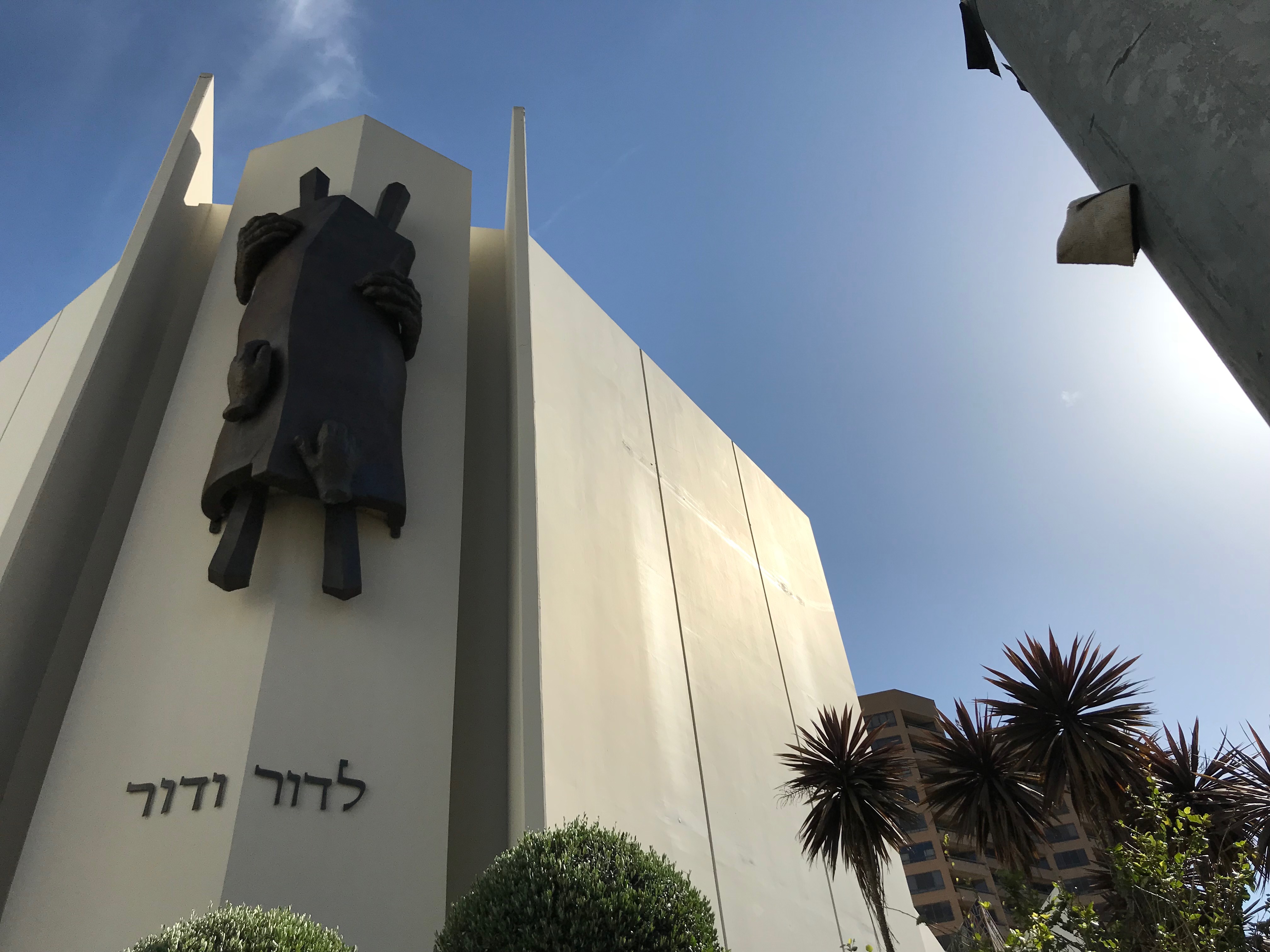
Founded in 1096, Sinai Temple was the first Conservative Jewish temple in Southern California. The original temple was located downtown but as the congregation expanded, a new temple was built in 1925 in what’s now Koreatown (that temple is now Joohyang Presbyterian Church). As Los Angeles’s Jewish population moved west, so did the temple, which opened at its present location on the Golden Mile in 1960.
Sephardic Temple Tifereth Israel was established in 1920. In 1931, a temple was dedicated in South Los Angeles (now home to Greater New Vision Missionary Baptist Church). Groundbreaking for the Westwood temple took place in 1970 but the temple wasn’t completed until 1981. It was in front of this temple that I caught my bus home and noticed that there were as many people (roughly a dozen) waiting for the 720 as I’d passed through the length of the Golden Mile.

The Westwood Presbyterian Church moved from their original home in 1949 into a real estate office, which was given a retrofit. In 1953, the Gothic-style sanctuary was completed.
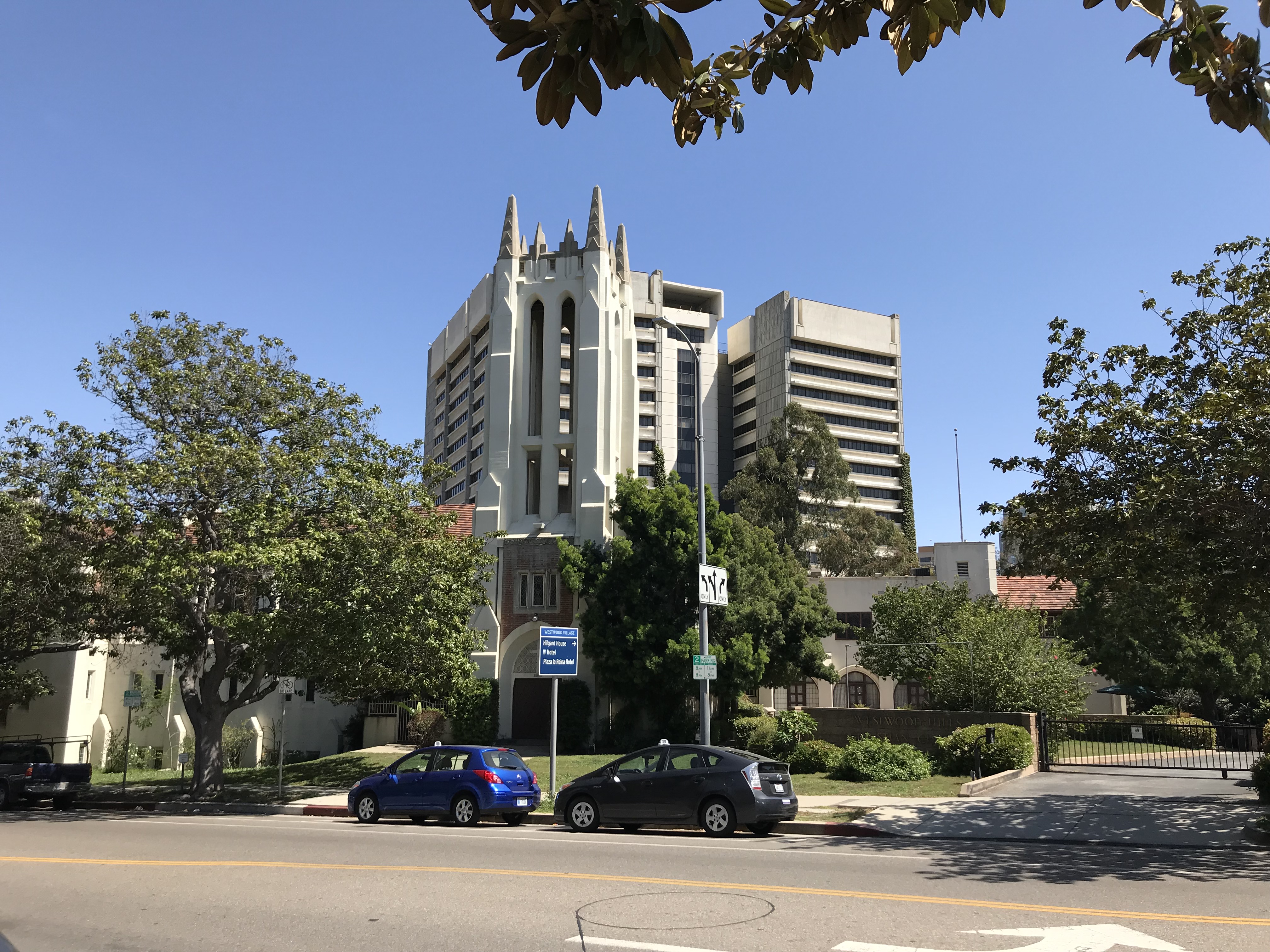
Other houses of worship in the neighborhood include Hillel Synagogues, Kahal Joseph Congregation, St Alban’s Episcopal Church, St Paul the Apostle Catholic Church, Twenty-eighth Church of Christ, United Methodist Church of Westwood, University Bible Church, University Catholic Center, University Lutheran Chapel, University Presbyterian Church, Westwood Hills Christian Church, and Westwood Kehilla Orthodox Synagogue.
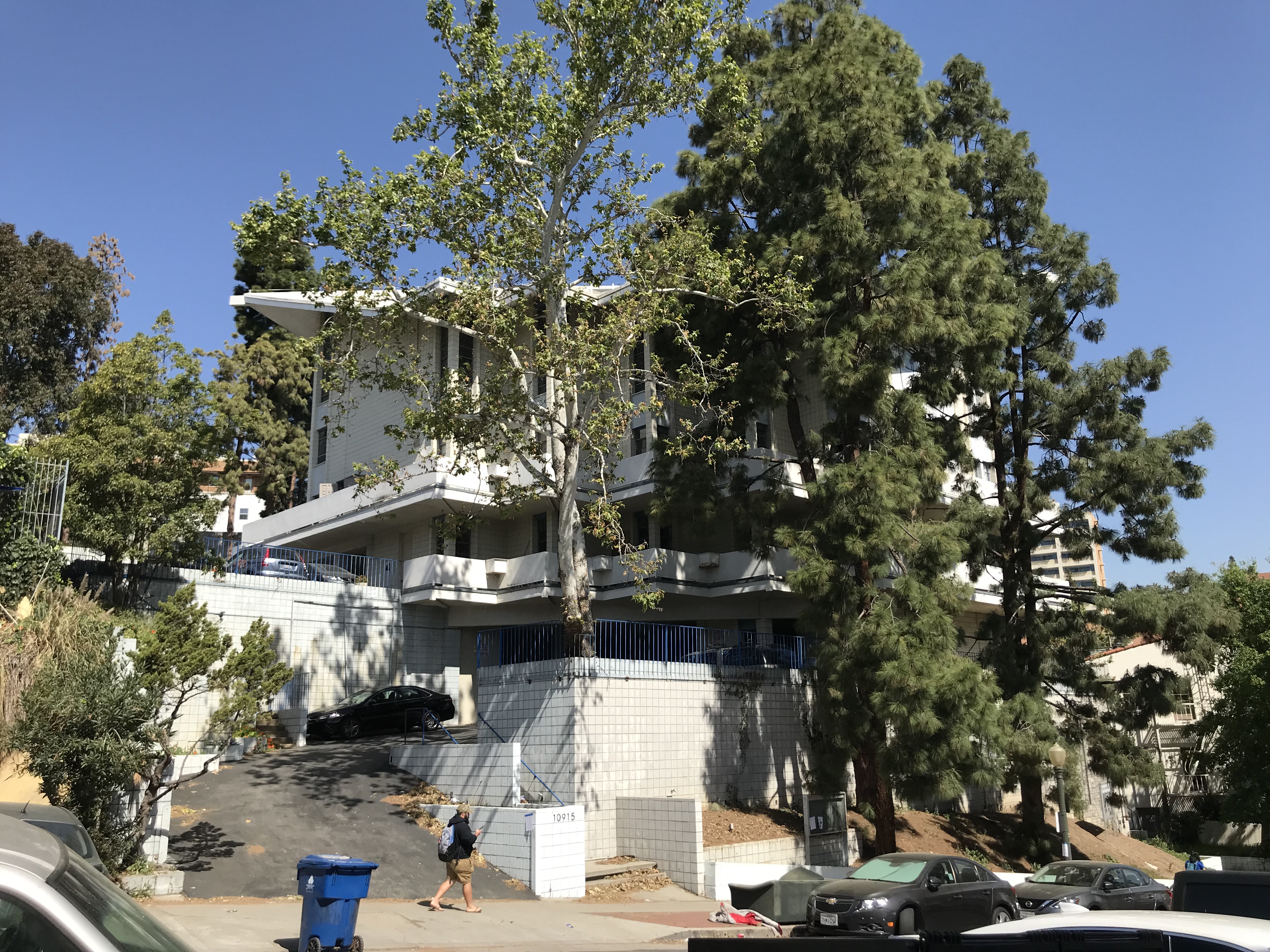
THE SHOOTING
As alluded to in the introduction, many Angelenos of a certain age are prone to reminiscing about the good old days of Westwood. Most of the blame for Westswood’s much-discussed “downfall” is penned on a shooting which took place in January 1988 that claimed the life of then 27-year-old graphic designer Karen Chikako Toshima at the hands of then 21-year-old Durrell Dewitt Collins, a member of the Rollin’ 60s Crips. Apparently, Collins was attempting to murder a member of the Mansfield Gangster Crips, Tyrone Swain, but his poorly-aimed shot unintendedly killed Toshima. Whilst undeniably a tragic, it’s impossible for me to understand how a once supposedly vibrant neighborhood wouldn’t be able to recover from a single violent incident which occurred thirty years ago. This is America, after all, where on an average day, 318 people are felled by guns.
The bad old days of the 1980s are behind us and today more Angelenos are killed or injured by cars (about 39 on an average day) than they are by gang violence. Some blame surely has to be placed on the Westwood Village Specific Plan, adopted by the Los Angeles City Council in 1989. It’s less hard to accept that a neighborhood would take more than 30 years to recover from misguided mismanagement. The Westwood Village Specific Plan favors parking over people and deliberately limits entertainment options. Ten years after the killing, Duet Restaurant and Nightclub was repeatedly cited for allowing patrons to dance without a permit. When the club owners applied for a permit, the Holmby-Westwood Homeowners Association successfully lobbied to block it. The club closed in 1999. Stunted by NIMBY-ism, Footloose puritanism, and automobile-centrism, there are today no dance clubs, no proper bars, no microbreweries, no barcades, no live music venues, no KTV/norebang, no pijiu wu, and no izakayas. If your idea of nightlife doesn’t involve attending a play, a film, or checking out a museum, your options are pretty much limited to Q’s Billiard Club or the shrine to bro-dom that is Barney’s Beanery. There is plenty of parking, though, thank God.
WESTWOOD CULTURE
That’s not to say that there are no entertainment options Westwood Village beside the cinemas and a pool hall. It’s just that it tends to be the sort of more sedate, event-based “high” culture that conservative city governments and pearl-clutching members of homeowners’ associations inevitably favor over more casual options. The website for Glendon Apartment paints an unintentionally depressing picture of life in Westwood Village, which it refers nonsensically to as “Los Angeles’ most authentic neighborhood.”
Culture comes in the form of catching a blockbuster movie at the historic Fox and Bruin theaters or a thought-provoking one-man play at the esteemed Geffen Playhouse. Best of all, Life at The Glendon means you might just choose to go nowhere – instead grabbing a sub sandwich at Jersey Mike’s…
There you have it. Go see a play. If you’ve already seen the play, grab a sandwich from Jersey Mike’s.
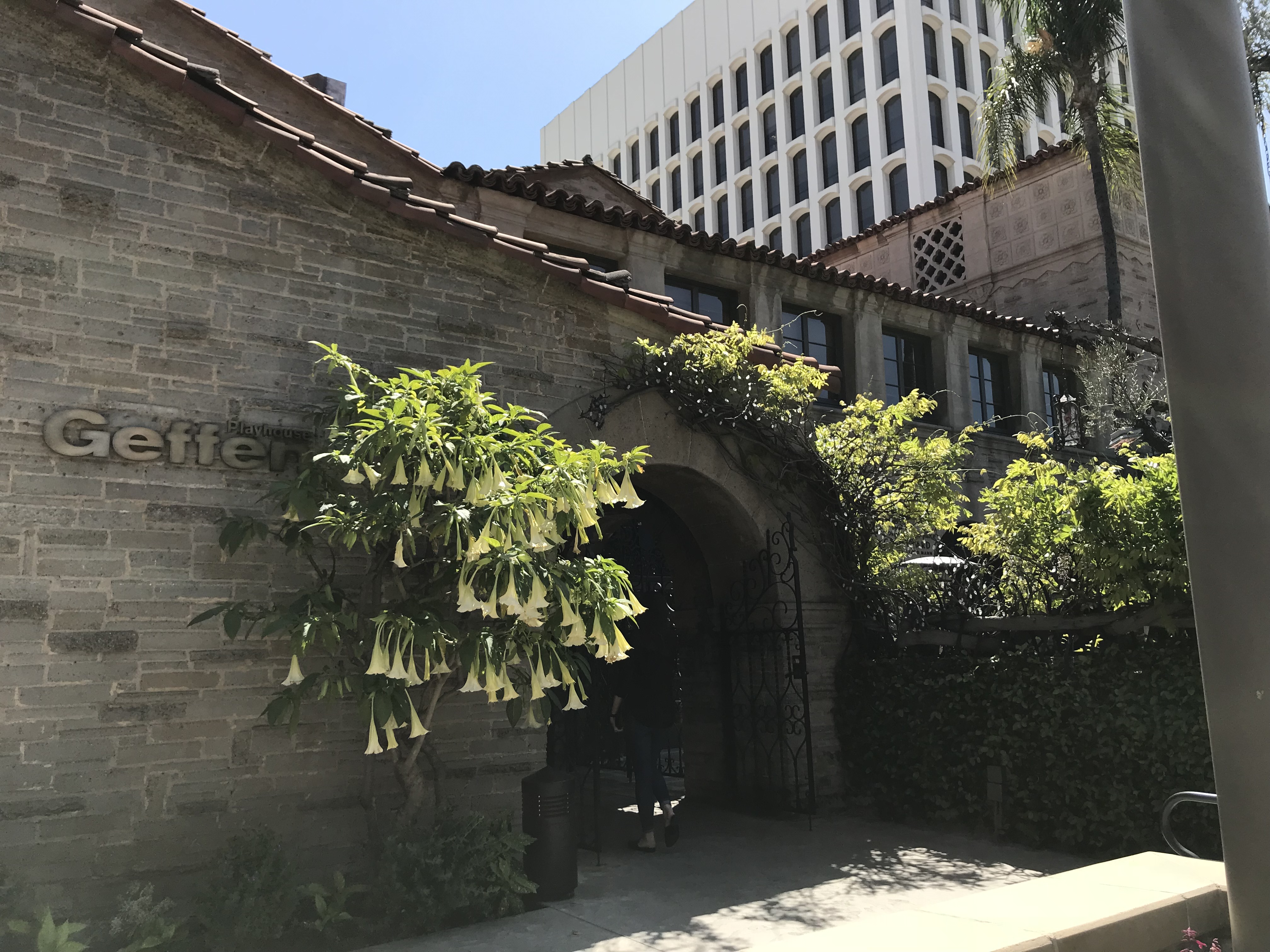
I’m not criticizing the Geffen, mind you, as I love live theater. I just have never wandered out of my apartment and flipped a coin to determine whether I’d see a play or eat a sanwich.
The building which houses the Geffen Playhouse is another of Westwood Village’s original buildings, built in 1929 for the Masonic Affiliates Club. It was designed by architect Stiles O. Clements. In the 1960s it was a furniture store known as Contempo Westwood and shows began being performed there amongst the furniture. After a while, the furniture was gone but the shows continued in the Westwood Playhouse. The Geffen Playhouse was founded by Gilbert Cates and is named after Geffen Records founder David Geffen, who made the initial donation to the theater. The playhouse took over the historic space in 1995.

The Hammer Museum is Westwood Village’s other high culture option — and likewise, I’m not criticizing it. In fact, I’m returning there in a couple of hours to see Unspeakable: Atlas, Kruger, Walker: Hammer Contemporary Collection. The Hammer is located in the former Occidental Petroleum Building, a Modern-style building designed by Claud Beelman and Edward Larrabee Barnes and completed in 1962. The Hammer Museum was founded by Occidental’s former chairman, Dr. Armand Hammer, and financed by that corporation. The museum opened in 1990 and Hammer passed away only three weeks later. In 1994, UCLA took over museum management.
GETTING THERE AND GETTING AROUND
Westwood is physically fairly walkable even if walking in Westwood isn’t always rewarding. The website Walk Score assigns Westwood a walk score of 69 out of 100 — a solid D+. By their reckoning, it’s the 46th most walkable neighborhood in the country’s 13th most walkable big city. The same website awards the neighborhood an even more unforgivable transit score of 62. Metro’s Purple Line is expected to arrive in Westwood sometime between 2024 and 2027, which when it opens will be the neighborhood’s one and only train line. There are public transit options, however, including Santa Monica’s Big Blue Bus, Culver City Bus, LADOT’s Commuter Express, the LAX Flyaway, UCLA’s BruinBus, and numerous Metro lines — but only Wilshire Boulevard has a dedicated bus lane so other buses are often frustratingly bogged down in traffic.
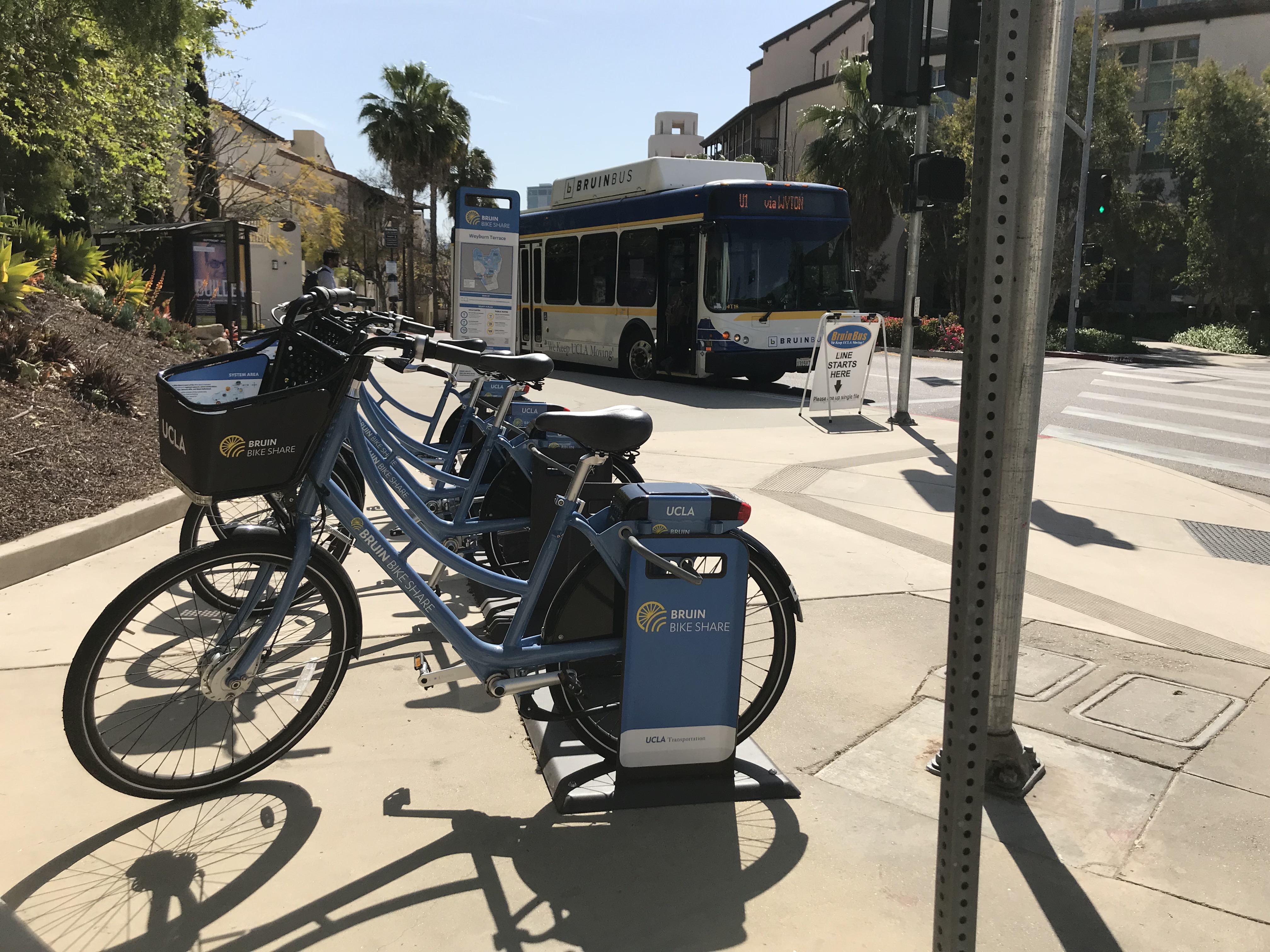
Walkscore also gives Westwood a bike score of 62. Only Santa Monica Boulevard has a substantial, dedicated bicycle lane. Very short stretches of Sepulveda, Le Conte, and Gayley do as well, and bicycles may use the bus lanes on Wilshire although that sounds rather frightening to me. There are three bicycle shops: Bike Improve, Helen’s Cycles, and the UCLA Bike Shop. In October 2017, UCLA launched the Bruin Bike Share and installed eighteen bike hubs throughout the 9.5 square kilometer neighborhood. I also saw quite a few Bird scooters and scooterists — including more than a few of the dreaded scofflaw scooterist whizzing past signs demanding that they dismount and reminding them that scooters are motorized vehicles. The horror.
WESTWOOD PARKS
A larger percentage of Westwood is devoted to parking lots than to actual parks. The largest green space located in the neighborhood, by far, is the Los Angeles Country Club — but it’s private. The country club was founded in 1897 as an ultra-exclusive and has snubbed numerous figures from the entertainment industry. Grouch Marx famously wrote “please accept my resignation. I don’t want to belong to any club that will accept people like me as a member” to the Friar’s Club of Beverly Hills. He wouldn’t have needed to write such a message to the Los Angeles Country Club, as they discriminated against Jews until at least 1978, the year after Marx’s death.
Next to the neighborhood but outside of it is the large Los Angeles National Cemetery. Westwood is also home to Pierce Brothers Westwood Village Memorial Park Cemetery, which has welcomed the remains of people of various faiths and backgrounds including Jack Arnold, John Cassavetes, and Edward Yang; writers Ray Bradbury and Truman Capote; cinematographer James Wong Howe; singers Peggy Lee and Roy Orbison; and many other well known figures from the entertainment industry, including Marilyn Monroe. The cemetery was officially established as Sunset Cemetery in 1905 but had been used as a graveyard since the 1880s. It acquired its current name in 1926.
If you don’t meet Los Angeles Country Club’s caste standards, aren’t a parked automobile, or aren’t dead, there is really just one option in the neighborhood — the Westwood Recreation Center, which includes on its grounds barbecue pits, a baseball diamond, basketball courts, racquetball courts, tennis courts, a handicapped accessible playground called Aidan’s Place, a community room, an indoor gymnasium, and a picnic table.
THE PRESENT
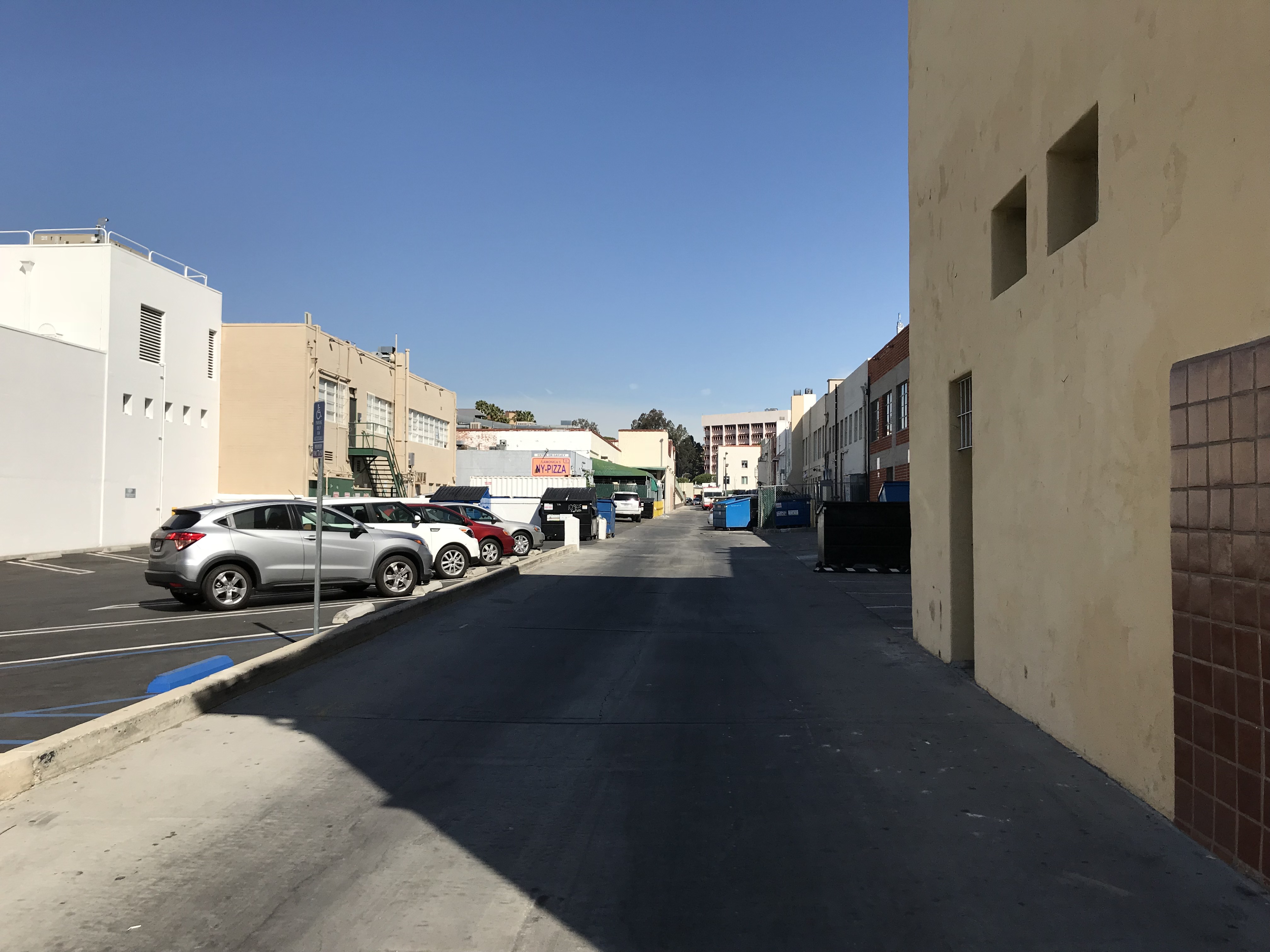

Although Westwood Village may have itself been the destination in the past, today I’m more likely to visit UCLA for an event. I have my own ideas about what should be done to Westwood Village. Although there’s next-to-no chance that any of my ideas will be adopted anytime soon — if they were, Westwood Village might again become the sort of place at which people would want to hang out rather than merely reminisce about.
- Close all streets of Westwood Village to private automobiles.
- Instead of limiting nightlife options, limit multinational chains and encourage bar density — it cuts down on drunk driving.
- Activate all of those dead alleys with murals, outdoor seating, and rear entrances to businesses.
- Replace all surface parking lots with parks and pedestrian plazas.
- Convert all street parking to bioswales and parklets.
- Plant a lot more (native) trees.
- Ask the folks at Taiwan Academy what a night market is and then hold one there every night.
- Maybe throw in a street car (as long as it’s privately funded).
Make Westwood Village great again! Until then, be seeing you.
FURTHER READING AND VIEWING
- Westwood By Marc Wanamaker (2010)
- Colin Marshall, A Los Angeles Primer: Westwood (2013)
Support Eric Brightwell on Patreon




Excellent – reminds me that it’s time I get back there. I have to add a shout out to one of my favorite LA architects, Stephen Kanner (1955-2010) who was responsible for some major restoration work of the Spanish Colonial Revival commercial district here as well as the In-n-out on Gayley. Kevin Roderick did a very informative piece on his LA Observed blog in 2010 about Kanner’s Westwood contributions.
LikeLike
I’ll look for Roderick’s piece, thanks!
LikeLike
Dear Eric:
I came across your blog today when researching about LA neighborhoods and just can’t stop reading.
Your works are truly appreciated!
Best,
Tingting
LikeLike
Thank you so much! It’s always nice to hear a kind word… and to know that the pieces I write are even being read!
Good luck and have fun exploring!
LikeLike
I’ve been following you for over 3 years now and LOVE all the things you share. It’s helping me with a project I’ve been working on for 5 years now. One day I would love to meet you and have you on my team!!!
LikeLike
Thank you, Shahara! I’m curious about your project and thanks for the kind words. I just got back from Japan and am fired up about exploring locally so expect more posts soon.
LikeLike